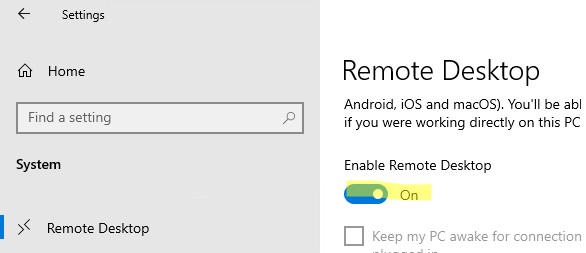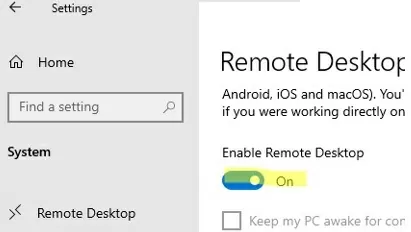Удаленные пользователи могут подключаться к своим компьютерам Windows 10 или 11 через службу удаленных рабочих столов (RDP). Достаточно включить удаленный рабочий стол (Remote Desktop), разрешить RDP доступ для пользователя и подключиться к компьютеру с помощью любого клиента удаленного рабочего стола. Однако в десктопных версия Windows есть ограничение на количество одновременных RDP сессии. Разрешается только один активный Remote Desktop сеанс пользователя.
Если вы попробуете открыть вторую RDP сессию, появится предупреждение с запросом отключить сеанс первого пользователя.
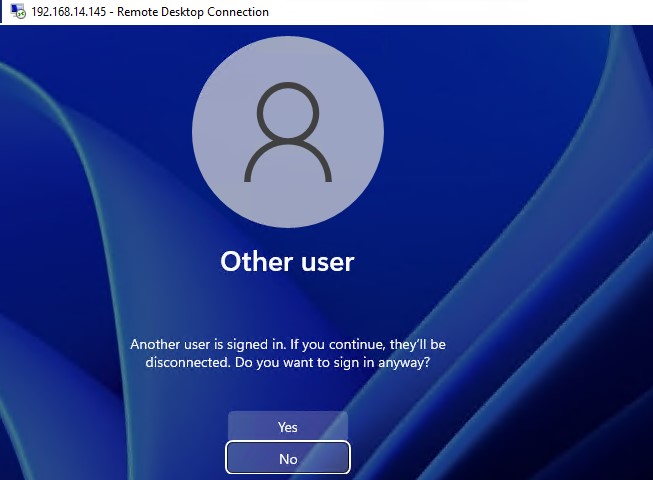
В систему вошел другой пользователь. Если вы продолжите, он будет отключен. Вы все равно хотите войти в систему?
В английской версии предупреждение такое:
Another user is signed in. If you continue, they’ll be disconnected. Do you want to sign in anyway?
Содержание:
- Ограничения на количество RDP сессий в Windows
- RDP Wrapper: разрешить несколько RDP сеансов в Windows
- Не работает RDP Wrapper в Windows
- Модификация файла termsrv.dll для снятия ограничений RDP в Windows 10 и 11
- Встроенная поддержка нескольких RDP сессий в редакции Windows 10 Enterprise Multi-session
Ограничения на количество RDP сессий в Windows
Во всех десктопных версиях Windows 10 и 11 есть ряд ограничений на использование служб удаленного рабочего стола
- Разрешено удаленно подключаться по RDP только к редакциям Windows Professional и Enterprise. В домашних редакциях (Home/Single Language) RDP доступ запрещен;
- Поддерживается только одно одновременное RDP подключение. При попытке запустить вторую RDP-сессию, пользователю будет предложено завершить активный сеанс;
- Если пользователь работает за консолью компьютера (локально), то при удаленном подключении по RDP, его локальный сеанс будет отключен (заблокирован). Также завершается и удаленный RDP сеанс, если пользователь входит в Windows через консоль компьютера.
Ограничение на количество одновременных RDP подключений в Windows является не техническим, но программным и лицензионным. Таким образом Microsoft запрещает создавать терминальный RDP сервер на базе рабочей станции для одновременной работы нескольких пользователей.
Если ваши задачи требуют развертывание терминального сервера, Microsoft предлагает пробрести Windows Server (по умолчанию разрешает 2 активных RDP подключения). Если вам нужно большее количество одновременных сессий пользователей, нужно приобрести лицензии RDS CAL, установить и настроить роль Remote Desktop Session Host (RDSH) или полноценную RDS ферму.
Технически любая редакция Windows при наличии достаточного ресурсов оперативной памяти и CPU может обслуживать одновременную работу нескольких десятков удаленных пользователей. В среднем на одну RDP сессию пользователя требуется 150-200 Мб памяти (без учета запускаемых приложений). Т.е. максимальное количество одновременных RDP сессий в теории ограничивается только ресурсами компьютера.
В этой статье мы покажем три способа убрать ограничение на количество одновременных RDP подключений в Windows 10 и 11:
- Использование RDP Wrapper
- Модификации системного файла termsrv.dll
- Апгрейд до редакции Windows 10/11 Enterprise for virtual desktops (multi-session)
Примечание. Все модификации операционной системы, описанные в этой статье, считаются нарушением лицензионного соглашения Windows, и вы можете использовать их на свой страх и риск.
Прежде, чем продолжить, проверьте что в настройках Windows включен протокол Remote Desktop.
- Откройте панель Settings -> System —> Remote Desktop -> включите опцию Enable Remote Desktop;
- Либо воспользуйтесь классической панель управления: выполните команду SystemPropertiesRemote -> Перейдите на вкладку Remote Settings (Удаленный доступ), включите опцию Allow remote connection to this computer (Разрешить удалённые подключения к этому компьютеру).
RDP Wrapper: разрешить несколько RDP сеансов в Windows
Open-source утилита RDP Wrapper Library позволяет разрешить конкурентные RDP сессии в Windows 10/11 без замены системного файла termsrv.dll.
RDP Wrapper работает в качестве прослойки между менеджером управления службами Service Control Manager, SCM) и службой терминалов (Remote Desktop Services). RDP Wrapper не вносит никаких изменений в файл termsrv.dll, просто загружая termsrv с изменёнными параметрами.
Важно. Перед установкой RDP Wrapper важно убедится, чтобы у вас использовалась оригинальная (непропатченная) версия файл termsrv.dll. Иначе RDP Wrapper может работать не стабильно, или вообще не запускаться.
Вы можете скачать RDP Wrapper из репозитория GitHub: https://github.com/binarymaster/rdpwrap/releases (последняя доступная версия RDP Wrapper Library v1.6.2). Утилита не обновляется с 2017 года, но ее можно использовать на всех билдах Windows 10 и 11. Для работы утилиты в современных версиях Windows достаточно обновить конфигурационный файл rdpwrap.ini.
Большинство антивирусов определяют RDP Wrapper как потенциально опасную программу. Например, встроенный Microsoft Defender антивирус классифицирует программу как PUA:Win32/RDPWrap (Potentially Unwanted Software) с низким уровнем угрозы. Если настройки вашего антивируса блокируют запуск RDP Wrapper, нужно добавить его в исключения.
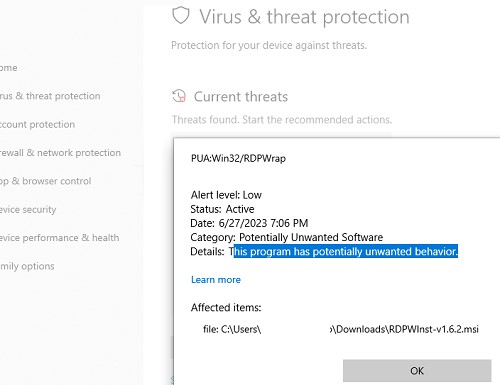
Архив RDPWrap-v1.6.2.zip содержит несколько файлов:
- RDPWinst.exe —программа установки/удаления RDP Wrapper Library;
- RDPConf.exe — утилита настройки RDP Wrapper;
- RDPCheck.exe — Local RDP Checker — утилита для проверки RDP доступа;
- install.bat, uninstall.bat, update.bat — пакетные файлы для установки, удаления и обновления RDP Wrapper.
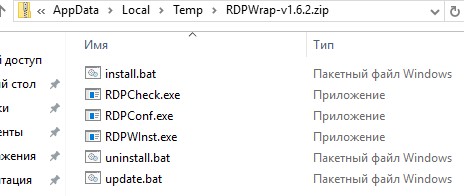
Чтобы установить RDPWrap, запустите файл
install.bat
с правами администратора.
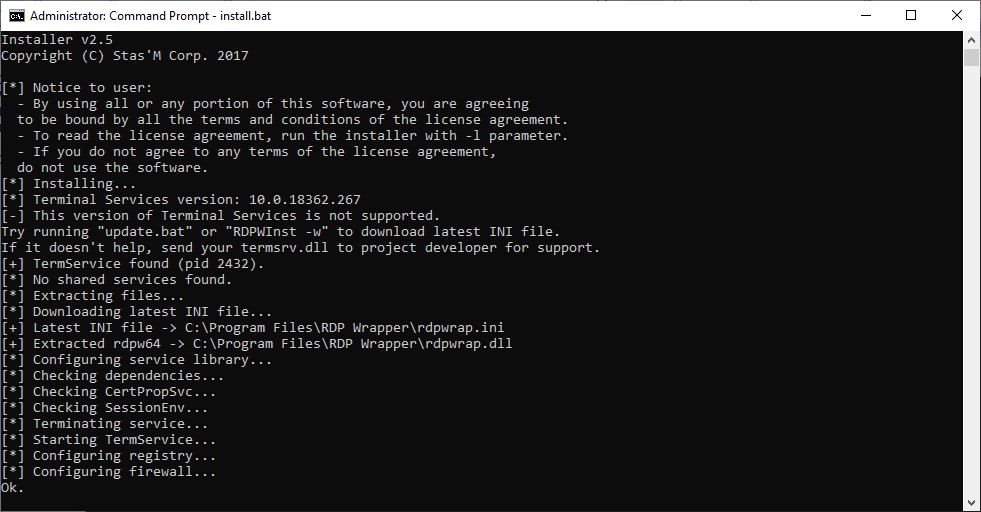
После окончания установки запустите RDPConfig.exe.
![rdp-wrapper: красная надпись не поддерживается [not supported]](https://winitpro.ru/wp-content/uploads/2015/09/rdp-wrapper-ne-podderzhivaetsya.jpg)
Скорее всего сразу после установки утилита покажет, что RDP wrapper запущен (Installed, Running, Listening), но не работает. Обратите внимание на красную надпись. Она сообщает, что данная версий Windows 10 (ver. 10.0.19041.1949) не поддерживается ([not supported]).
Причина в том, что в конфигурационном файле rdpwrap.ini отсутствует секция с настройками для вашего версии (билда) Windows. Актуальную версию файла rdpwrap.ini можно скачать здесь https://raw.githubusercontent.com/sebaxakerhtc/rdpwrap.ini/master/rdpwrap.ini
Вручную скопируйте содержимое данной страницы в файл «C:\Program Files\RDP Wrapper\rdpwrap.ini». Или скачайте файл с помощью PowerShell командлета Invoke-WebRequest (предварительно нужно остановить службу Remote Desktop):
Stop-Service termservice -Force
Invoke-WebRequest https://raw.githubusercontent.com/sebaxakerhtc/rdpwrap.ini/master/rdpwrap.ini -outfile "C:\Program Files\RDP Wrapper\rdpwrap.ini"
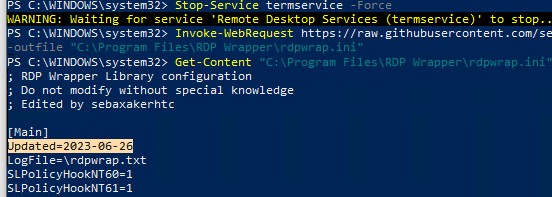
alert] Можно создать задание планировщика для проверки изменений в файле rdpwrap.ini и его автоматического обновления [/alert]
На данном скриншоте видно, что на компьютере установлена свежая версия файла rdpwrap.ini (Updated=2023-06-26).
Перезагрузите компьютер, запустите утилиту RDPConfig.exe. Проверьте, что в секции Diagnostics все элементы окрашены в зеленый цвет, и появилось сообщение [Fully supported]. На скриншоте ниже показано, что RDP Wrapper с данным конфигом успешно запущен в Windows 11 22H2.
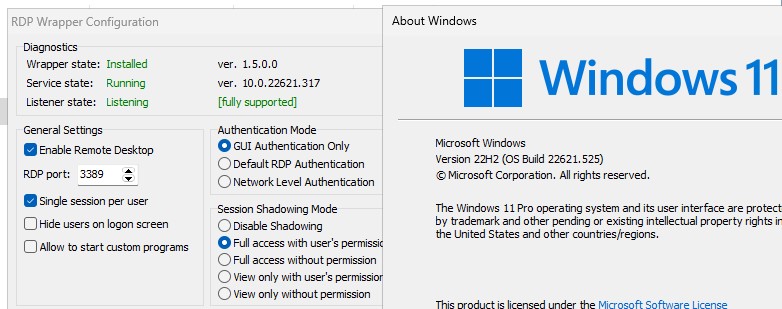
Теперь попробуйте установить несколько одновременных RDP сессий с этим компьютером под разными пользователями (воспользуйтесь любым RDP клиентом: mstsc.exe, RDCMan, mRemoteNG и т.д.).
Можете проверить что на компьютере активны одновременно две RDP сессии (или более) с помощью команды:
qwinsta
rdp-tcp#0 user1 1 Active rdp-tcp#1 user2 2 Active


Утилита RDPWrap поддерживается во версиях Windows (включая домашние редакции Windows Home), таким образом из любой клиентской версии Windows можно сделать полноценный сервер терминалов.
В интерфейсе RDP Wrapper доступны следующие опции:
- Enable Remote Desktop — включить/отключить Remote Desktop в Windows доступ
- RDP Port — можно изменить стандартный номера порта удаленного рабочего стола TCP 3389
- Опция Hide users on logon screen позволяет скрыть список пользователей на экране приветствия;
- Single session per user —разрешить несколько одновременных RDP сессий под одной учетной записью пользователя. Эта опция устанавливает параметр реестра fSingleSessionPerUser = 0 в ветке HKLM\SYSTEM\CurrentControlSet\Control\Terminal Server). Также этот параметр настраивается через опцию GPO Restrict Remote Desktop Services to a single Remote Desktop Services session в разделе Computer Configuration > Administrative Templates > Windows Components > Remote Desktop Services > Remote Desktop Session Host > Connections.
- В секции Session Shadowing Mode вы можете настроить режим теневого подключения к рабочему столу пользователей Windows .
Не работает RDP Wrapper в Windows
В некоторых случая утилита RDP Wrapper не работает как ожидается, и вы не можете использовать несколько RDP подключений.
Во время установки обновлений Windows может обновиться версия файла termsrv.dll. Если в файле rdpwrap.ini отсутствует описание для вашей версии Windows, значит RDP Wrapper не может применить необходимые настройки. В этом случае в окне RDP Wrapper Configuration будет указан статус [not supported].
В этом случае нужно обновить файл rdpwrap.ini как описано выше.
Если RDP Wrapper не работает после обновления файла rdpwrap.ini, попробуйте открыть файл rdpwrap.ini и найти в нем описание для вашей версии Windows.
Как понять, есть ли поддержка вашей версии Windows в конфиг файле rdpwrapper?
На скриншоте ниже показано, что для моей версии Windows 11 (10.0.22621.317) есть две секции с описаниями:
[10.0.22621.317] ... [10.0.22621.317-SLInit] ...
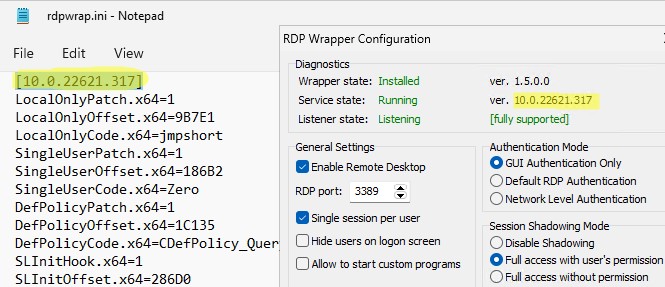
Если в конфигурационном файле rdpwrap соответствующая секция отсутствует для вашей версии Windows, попробуйте поискать в сети строки rdpwrap.ini для вашего билда. Добавьте найденные строки в самый конец файла.
Если после установки обновлений безопасности или после апгрейда билда Windows 10, RDP Wrapper не работает, проверьте, возможно в секции Diagnostics присутствует надпись Listener state: Not listening.
Попробуйте обновить ini файл, и затем переустановить службу:
rdpwinst.exe -u
rdpwinst.exe -i
Бывает, что при попытке второго RDP подключения под другим пользователем у вас появляется надпись:
Число разрешенных подключений к этому компьютеру ограничено и все подключений уже используются. Попробуйте подключиться позже или обратитесь к системному администратору.
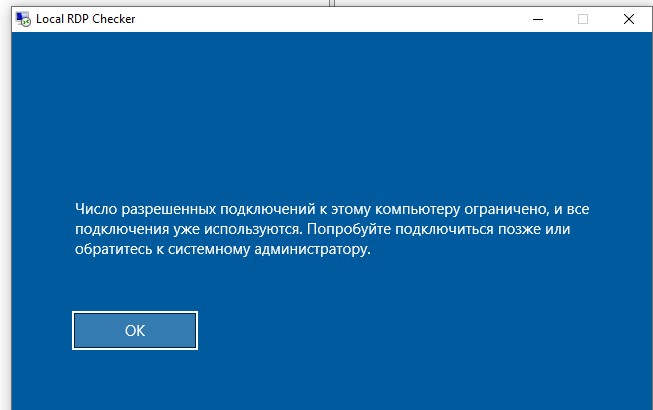
The number of connections to this computer is limited and all connections are in use right now. Try connecting later or contact your system administrator.
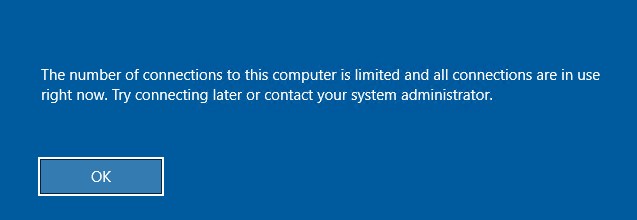
В этом случае нужно с помощью редактора групповых политики gpedit.msc в секции Конфигурация компьютера –> Административные шаблоны -> Компоненты Windows -> Службы удаленных рабочих столов -> Узел сеансов удаленных рабочих столов -> Подключения включить политику “Ограничить количество подключений” и изменить ее значение на 999999 (Computer Configuration -> Administrative Templates -> Windows Components ->Remote Desktop Services ->Remote Desktop Session Host -> Connections-> Limit number of connections).
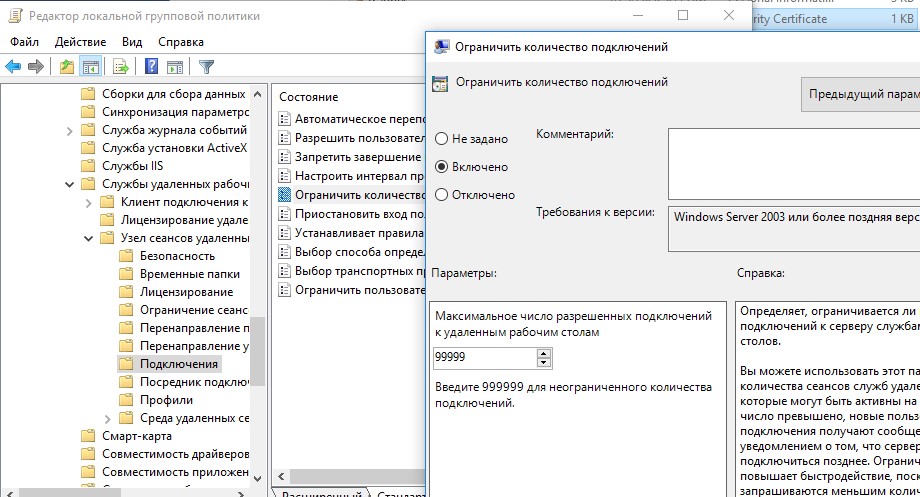
Перезагрузите компьютер для обновления настроек GPO и применения новых параметров.
Модификация файла termsrv.dll для снятия ограничений RDP в Windows 10 и 11
Чтобы убрать ограничение на количество RDP подключений пользователей в Windows без использования rdpwrapper нужно заменить файл termsrv.dll. Это файл библиотеки, которая используется службой Remote Desktop Services. Файл находится в каталоге C:\Windows\System32.
Прежде, чем править или заменять файл termsrv.dll желательно создать его резервную копию. Это поможет вам в случае необходимости можно будет вернуться к исходной версии файла. Запустите командную строку с правами администратора и выполните команду:
copy c:\Windows\System32\termsrv.dll termsrv.dll_backup
Затем нужно стать владельцем файла. Проще всего это сделать из командной строки. Чтобы сменить владельца файла с TrustedInstaller на группу локальных администраторов с помощью команды:
takeown /F c:\Windows\System32\termsrv.dll /A
Должно появится сообщение: «SUCCESS: The file (or folder): «c:\Windows\System32\termsrv.dll» now owned by the administrators group».
Теперь с помощью icacls.exe предоставьте группе локальных администраторов полные права на файл termsrv.dll (Full Control):
icacls c:\Windows\System32\termsrv.dll /grant Administrators:F
(или
Администраторы
в русской версии Windows).
Должно появится сообщение: «processed file: c:\Windows\System32\termsrv.dll Successfully processed 1 files; Failed processing 0 files«.

Теперь нужно остановить службу Remote Desktop Service (TermService) из консоли services.msc или из командной строки:
Net stop TermService
Вместе с ней останавливается служба Remote Desktop Services UserMode Port Redirector.
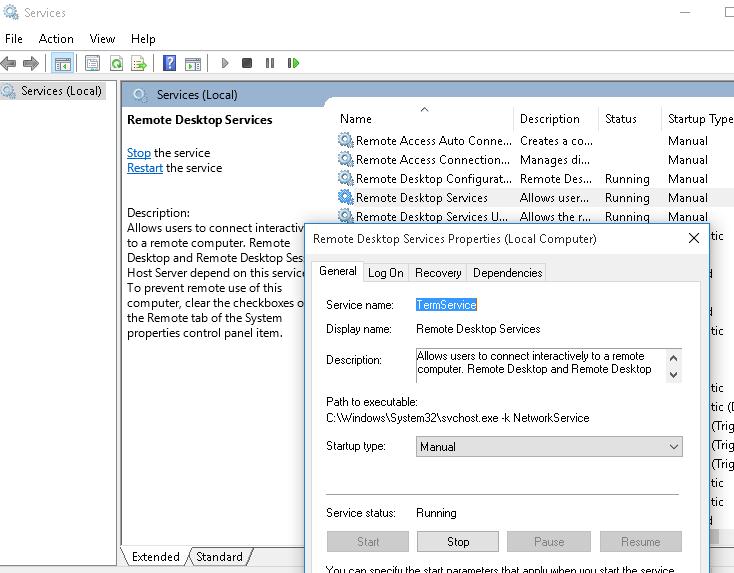
Чтобы узнать номер билда вашей Windows, выполните команду winver или следующую команды PowerShell:
Get-ComputerInfo | select WindowsProductName, WindowsVersion
В моем случае установлена Windows 10 билд 22H2.
Затем откройте файл termsrv.dll с помощью любого HEX редактора (к примеру, Tiny Hexer). В зависимости от билда нужно найти и заменить строку:
| Версия Windows | Найти строку | Заменить на |
| Windows 11 22H2 | 39 81 3C 06 00 00 0F 84 75 7A 01 00 |
B8 00 01 00 00 89 81 38 06 00 00 90 |
| Windows 10 22H2 | 39 81 3C 06 00 00 0F 84 85 45 01 00 | |
| Windows 11 RTM ( 21H2 22000.258) | 39 81 3C 06 00 00 0F 84 4F 68 01 00 | |
| Windows 10 x64 21H2 | 39 81 3C 06 00 00 0F 84 DB 61 01 00 | |
| Windows 10 x64 21H1 | 39 81 3C 06 00 00 0F 84 2B 5F 01 00 | |
| Windows 10 x64 20H2 | 39 81 3C 06 00 00 0F 84 21 68 01 00 | |
| Windows 10 x64 2004 | 39 81 3C 06 00 00 0F 84 D9 51 01 00 | |
| Windows 10 x64 1909 | 39 81 3C 06 00 00 0F 84 5D 61 01 00 | |
| Windows 10 x64 1903 | 39 81 3C 06 00 00 0F 84 5D 61 01 00 | |
| Windows 10 x64 1809 | 39 81 3C 06 00 00 0F 84 3B 2B 01 00 | |
| Windows 10 x64 1803 | 8B 99 3C 06 00 00 8B B9 38 06 00 00 | |
| Windows 10 x64 1709 | 39 81 3C 06 00 00 0F 84 B1 7D 02 00 |
Редактор Tiny Hexer не позволяет редактировать файл termsvr.dll напрямую из папки system32. Скопируйте его на рабочий стол, а после модификации замените исходный файл.
Например, для самой редакции Windows 10 x64 22H2 19045.2006 (версия файла termsrv.dll — 10.0.19041.1949) нужно открыть файл termsrv.dll в Tiny Hexer. Затем найдите строку:
39 81 3C 06 00 00 0F 84 85 45 01 00
И замените ее на:
B8 00 01 00 00 89 81 38 06 00 00 90
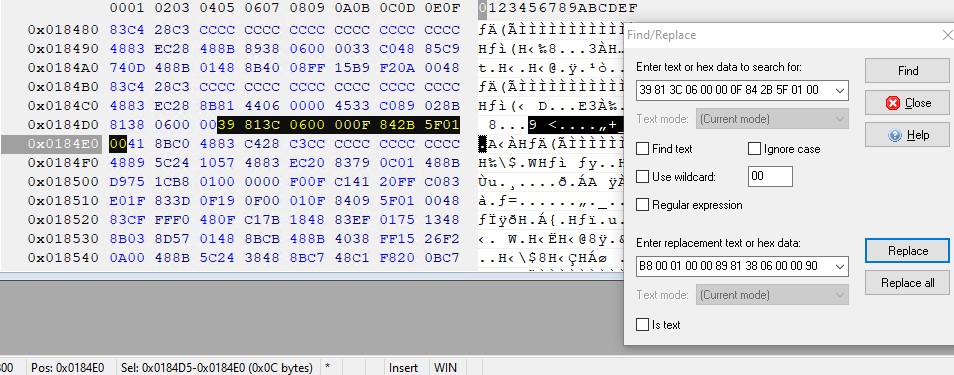
Сохраните файл и запустите службу TermService.
Если что-то пошло не так, и у вас возникнут проблемы со службой RDP, остановите службу и замените модифицированный файл termsrv.dll исходной версией:
copy termsrv.dll_backup c:\Windows\System32\termsrv.dll
Преимущество способа отключения ограничения на количество RDP сессий в Windows путем замены файла termsrv.dll в том, что на него не реагируют антивирусы. В отличии от утилиты RDPWrap, которую многие антивирусов считают Malware/HackTool/Trojan. Основной недостаток — вам придется вручную править файл после каждого обновления билда Windows (или при обновлении версии файла termsrv.dll в рамках ежемесячных кумулятивных обновлений).
Встроенная поддержка нескольких RDP сессий в редакции Windows 10 Enterprise Multi-session
Недавно Microsoft выпустило специальные Enterprise редакции Windows multi-session (ранее назывались Windows 10 Enterprise for Remote Sessions и Windows 10 Enterprise for Virtual Desktops).
Редакция Enterprise multi-session доступна как для Windows 10, так и для Windows 11.
Главная особенность этой редакции – она поддерживает множественные одновременные RDP сессии пользователей прямо из коробки. Несмотря на то, что редакцию Windows multi-session разрешено запускать только в виртуальных машинах Azure, вы можете вам установить эту редакцию в on-premises сети и использовать данный компьютер терминальный сервер (хотоя это будет нарушением лицензионной политики Microsoft).
Далее мы покажем, как обновить компьютер с Windows 10 Pro до Windows 10 Enterprise for Virtual Desktop и использовать его для одновременного подключения нескольких пользователей.
Откройте командную строку и проверьте текущую редакцию Windows (Professional в этом примере):
DISM /online /Get-CurrentEdition
Обновите вашу редакцию Windows с Pro до Enterprise:
Changepk.exe /ProductKey NPPR9-FWDCX-D2C8J-H872K-2YT43
Теперь установить GVLK ключ для Windows 10 Enterprise for Remote Sessions:
slmgr.vbs /ipk CPWHC-NT2C7-VYW78-DHDB2-PG3GK
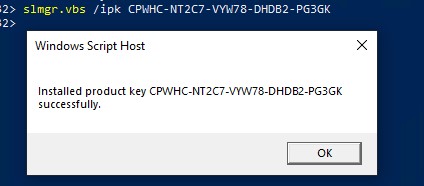
Проверьте, что теперь ваша редакция Windows 10 изменилась на
ServerRdsh
(Windows 10 Enterprise for Virtual Desktops).

Активируйте вашу копию Windows Enterprise Multi-Session на вашем KMS сервере:
slmgr /skms msk-man02.winitpro.local:1688
slmgr /ato
Откройте редактор локальной GPO
(gpedit.msc
) и включите Per-User режим лицензирования в параметре Set the Remote Desktop licensing mode (Computer Configuration -> Policies -> Administrative Templates -> Windows Components -> Remote Desktop Services -> Remote Desktop Session Host -> Licensing).
После активации нужно перезагрузить Windows. Теперь попробуйте подключиться к компьютеру по RDP под несколькими пользованиями. Как вы видите, Windows 10 Enterprise multi-session одновременные RDP подключения поддерживаются прямо из коробки.
Get-ComputerInfo | select WindowsProductName, WindowsVersion, OsHardwareAbstractionLayer
Windows 10 Enterprise for Virtual Desktops 2009 10.0.19041.2728
qwinsta
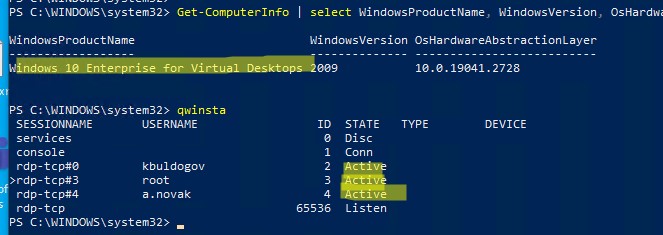
В этой статье мы рассмотрели способы, позволяющие снять ограничение на количество одновременных RDP подключений пользователей, и запустить бесплатный терминальный сервер на клиентской Windows 10 или 11. У каждого из этих способов есть свои преимущества и недостатки. Какой из них использовать — решать вам.
RDP Wrapper Library by Stas’M
The goal of this project is to enable Remote Desktop Host support and concurrent RDP sessions on reduced functionality systems for home usage.
RDP Wrapper works as a layer between Service Control Manager and Terminal Services, so the original termsrv.dll file remains untouched. Also this method is very strong against Windows Update.
| NT Version | Screenshots |
|---|---|
| Windows Vista | |
| Windows 7 | |
| Windows 8 | |
| Windows 8.1 | |
| Windows 10 |
This solution was inspired by Windows Product Policy Editor, big thanks to kost 
— binarymaster
Attention:
It’s recommended to have original termsrv.dll file with the RDP Wrapper installation. If you have modified it before with other patchers, it may become unstable and crash in any moment.
Information:
- Source code is available, so you can build it on your own
- RDP Wrapper does not patch termsrv.dll, it loads termsrv with different parameters
- RDPWInst and RDPChecker can be redistributed without development folder and batch files
- RDPWInst can be used for unattended installation / deployment
- Windows 2000, XP and Server 2003 will not be supported
Key features:
- RDP host server on any Windows edition beginning from Vista
- Console and remote sessions at the same time
- Using the same user simultaneously for local and remote logon (see configuration app)
- Up to 15 concurrent sessions (the actual limitation depends on your hardware and OS version)
- Console and RDP session shadowing (using Task Manager in Windows 7 and lower, and Remote Desktop Connection in Windows 8 and higher)
- Full multi-monitor support for RDP host
- …and if you find a new feature not listed here, tell us
Porting to other platforms:
- ARM for Windows RT (see links below)
- IA-64 for Itanium-based Windows Server? Well, I have no idea
Building the binaries:
- x86 Delphi version can be built with Embarcadero RAD Studio 2010
- x86/x64 C++ version can be built with Microsoft Visual Studio 2013
Links:
- Official GitHub repository:
https://github.com/stascorp/rdpwrap/ - Official Telegram chat:
https://t.me/rdpwrap - Active discussion in the comments here:
Enable remote desktop on Windows 8 core / basic — Andrew Block .net - MDL Projects and Applications thread here:
RDP Wrapper Library (works with Windows 8.1 Basic) - Some ideas about porting to ARM for Windows RT (post #23):
[Q] Mod Windows RT to enable Remote Desktop - Adding «Remote Desktop Users» group:
http://superuser.com/questions/680572/
Tutorial videos:
- Updating RDP Wrapper INI file manually (now use installer to update INI file)
- How to find offsets for new termsrv.dll versions
Files in release package:
| File name | Description |
|---|---|
RDPWInst.exe |
RDP Wrapper Library installer/uninstaller |
RDPCheck.exe |
Local RDP Checker (you can check the RDP is working) |
RDPConf.exe |
RDP Wrapper Configuration |
install.bat |
Quick install batch file |
uninstall.bat |
Quick uninstall batch file |
update.bat |
Quick update batch file |
Frequently Asked Questions
Where can I download the installer or binaries?
In the GitHub Releases section.
Is it legal to use this application?
There is no definitive answer, see this discussion.
The installer tries to access the Internet, is it normal behaviour?
Yes, it works in online mode by default. You may disable it by removing -o flag in the install.bat file.
What is online install mode?
Online install mode introduced in version 1.6.1. When you installing RDP Wrapper first time using this mode, it will download latest INI file from GitHub. See this discussion.
What is INI file and why we need it?
INI file was introduced in version 1.5. It stores system configuration for RDP Wrapper — general wrapping settings, binary patch codes, and per build specific data. When new termsrv.dll build comes out, developer adds support for it by updating INI file in repository.
Config Tool reports version 1.5, but I installed higher version. What’s the matter?
Beginning with version 1.5 the rdpwrap.dll is not updated anymore, since all settings are stored in INI file. Deal with it.
Config Tool shows
[not supported]and RDP doesn’t work. What can I do?
Make sure you’re connected to the Internet and run update.bat.
Update doesn’t help, it still shows
[not supported].
Visit issues section, and check whether your termsrv.dll build is listed here. If you can’t find such issue, create a new — specify your build version for adding to support.
Why
RDPCheckdoesn’t allow to change resolution and other settings?
RDPCheck is a very simple application and only for testing purposes. You need to use Microsoft Remote Desktop Client (mstsc.exe) if you want to customize the settings. You can use 127.0.0.1 or 127.0.0.2 address for loopback connection.
Known issues:
- Beginning with Windows 8 on tablet PCs inactive sessions will be logged out by system — more info
- Beginning with Windows 10 you can accidentally lock yourself from PC — more info
- Beginning with the Creators Update for Windows 10 Home, RDP Wrapper will no longer work, claiming that the listener is
[not listening]because ofrfxvmt.dllis missing — more info, download links - Terminal Service does not start after installing some updates or «Access Denied» issue — #215, #101
- RDP Wrapper does not work with RemoteFX enabled hosts — #127, #208, #216
- RDP works, but termsrv.dll crashes on logon attempt — Windows Vista Starter RTM x86 (termsrv.dll
6.0.6000.16386) - If Terminal Services hangs at startup, try to add
rdpwrap.dllto antivirus exclusions. Also try to isolate RDP Wrapper from other shared services by the command:
sc config TermService type= own - RDP Wrapper can be removed by AVG Free Antivirus and Norton Antivirus — first make sure you downloaded official release from GitHub, then add it to exclusions.
Change log:
2017.12.27
- Version 1.6.2
- Installer updated
- Include updated INI file for latest Windows builds
- Added check for supported Windows versions (#155)
- Added feature to take INI file from current directory (#300)
- Added feature to restore rfxvmt.dll (missing in Windows 10 Home #194)
- RDP Config updated
- Added feature to allow custom start programs (#13 (comment))
- MSI installation package added (#14)
2016.08.01
- Version 1.6.1
- Include updated INI file for latest Windows builds
- Installer updated
- Added online install mode
- Added feature to keep settings on uninstall
- RDP Config updated
- Fixed update firewall rule on RDP port change
- Added feature to hide users on logon
2015.08.12
- Version 1.6
- Added support for Windows 10
- INI file has smaller size now — all comments are moved to KB file
- Installer updated
- Added workaround for 1056 error (although it isn’t an error)
- Added update support to installer
- Newest RDPClip versions are included with installer
- RDP Checker updated
- Changed connect IP to 127.0.0.2
- Updated some text messages
- RDP Config updated
- Added all possible shadowing modes
- Also it will write settings to the group policy
2014.12.11
- Version 1.5
- Added INI config support
- Configuration is stored in INI file now
- We can extend version support without building new binaries
- Added support for Windows 8.1 with KB3000850
- Added support for Windows 10 Technical Preview Update 2
- Installer updated
- RDP Config updated
- Diagnostics feature added to RDP Config
2014.11.14
- Version 1.4
- Added support for Windows 10 Technical Preview Update 1
- Added support for Windows Vista SP2 with KB3003743
- Added support for Windows 7 SP1 with KB3003743
- Added new RDP Configuration Program
2014.10.21
- Installer updated
- Added feature to install RDP Wrapper to System32 directory
- Fixed issue in the installer — NLA setting now remains unchanged
- Local RDP Checker updated
- SecurityLayer and UserAuthentification values changed on check start
- RDP Checker restores values on exit
2014.10.20
- Version 1.3
- Added support for Windows 10 Technical Preview
- Added support for Windows 7 with KB2984972
- Added support for Windows 8 with KB2973501
- Added extended support for Windows Vista (SP0, SP1 and SP2)
- Added extended support for Windows 7 (SP0 and SP1)
- Some improvements in the source code
- Installer updated to v2.2
- Fixed installation bug in Vista x64 (wrong expand path)
- Local RDP Checker updated
- Added description to error 0x708
2014.07.26
- Version 1.2
- Added support for Windows 8 Developer Preview
- Added support for Windows 8 Consumer Preview
- Added support for Windows 8 Release Preview
- Added support for Windows 8.1 Preview
- Added support for Windows 8.1
- More details you will see in the source code
- Installer updated to v2.1
2013.12.09
- C++ port of RDP Wrapper was made by Fusix
- x64 architecture is supported now
- Added new command line installer v2.0
- Added local RDP checker
- Source code (C++ port, installer 2.0, local RDP checker) is also included
2013.10.25
- Version 1.1 source code is available
2013.10.22
- Version 1.1
- Stable release
- Improved wrapper (now it can wrap internal unexported termsrv.dll SL Policy function)
- Added support for Windows 8 Single Language (tested on Acer Tablet PC with Intel Atom Z2760)
2013.10.19
- Version 1.0
- First [beta] version
- Basic SL Policy wrapper
Supported Terminal Services versions:
- 6.0.X.X (Windows Vista / Server 2008)
- 6.0.6000.16386 (Windows Vista)
- 6.0.6001.18000 (Windows Vista SP1)
- 6.0.6002.18005 (Windows Vista SP2)
- 6.0.6002.19214 (Windows Vista SP2 with KB3003743 GDR)
- 6.0.6002.23521 (Windows Vista SP2 with KB3003743 LDR)
- 6.1.X.X (Windows 7 / Server 2008 R2)
- 6.1.7600.16385 (Windows 7)
- 6.1.7600.20890 (Windows 7 with KB2479710)
- 6.1.7600.21316 (Windows 7 with KB2750090)
- 6.1.7601.17514 (Windows 7 SP1)
- 6.1.7601.21650 (Windows 7 SP1 with KB2479710)
- 6.1.7601.21866 (Windows 7 SP1 with KB2647409)
- 6.1.7601.22104 (Windows 7 SP1 with KB2750090)
- 6.1.7601.18540 (Windows 7 SP1 with KB2984972 GDR)
- 6.1.7601.22750 (Windows 7 SP1 with KB2984972 LDR)
- 6.1.7601.18637 (Windows 7 SP1 with KB3003743 GDR)
- 6.1.7601.22843 (Windows 7 SP1 with KB3003743 LDR)
- 6.1.7601.23403 (Windows 7 SP1 with KB3125574)
- 6.1.7601.24234 (Windows 7 SP1 with KB4462923)
- 6.2.8102.0 (Windows 8 Developer Preview)
- 6.2.8250.0 (Windows 8 Consumer Preview)
- 6.2.8400.0 (Windows 8 Release Preview)
- 6.2.9200.16384 (Windows 8 / Server 2012)
- 6.2.9200.17048 (Windows 8 with KB2973501 GDR)
- 6.2.9200.21166 (Windows 8 with KB2973501 LDR)
- 6.3.9431.0 (Windows 8.1 Preview)
- 6.3.9600.16384 (Windows 8.1 / Server 2012 R2)
- 6.3.9600.17095 (Windows 8.1 with KB2959626)
- 6.3.9600.17415 (Windows 8.1 with KB3000850)
- 6.3.9600.18692 (Windows 8.1 with KB4022720)
- 6.3.9600.18708 (Windows 8.1 with KB4025335)
- 6.3.9600.18928 (Windows 8.1 with KB4088876)
- 6.3.9600.19093 (Windows 8.1 with KB4343891)
- 6.4.9841.0 (Windows 10 Technical Preview)
- 6.4.9860.0 (Windows 10 Technical Preview Update 1)
- 6.4.9879.0 (Windows 10 Technical Preview Update 2)
- 10.0.9926.0 (Windows 10 Pro Technical Preview)
- 10.0.10041.0 (Windows 10 Pro Technical Preview Update 1)
- 10.0.10240.16384 (Windows 10 RTM)
- 10.0.10586.0 (Windows 10 TH2 Release 151029-1700)
- 10.0.10586.589 (Windows 10 TH2 Release 160906-1759 with KB3185614)
- 10.0.11082.1000 (Windows 10 RS1 Release 151210-2021)
- 10.0.11102.1000 (Windows 10 RS1 Release 160113-1800)
- 10.0.14251.1000 (Windows 10 RS1 Release 160124-1059)
- 10.0.14271.1000 (Windows 10 RS1 Release 160218-2310)
- 10.0.14279.1000 (Windows 10 RS1 Release 160229-1700)
- 10.0.14295.1000 (Windows 10 RS1 Release 160318-1628)
- 10.0.14300.1000 (Windows Server 2016 Technical Preview 5)
- 10.0.14316.1000 (Windows 10 RS1 Release 160402-2227)
- 10.0.14328.1000 (Windows 10 RS1 Release 160418-1609)
- 10.0.14332.1001 (Windows 10 RS1 Release 160422-1940)
- 10.0.14342.1000 (Windows 10 RS1 Release 160506-1708)
- 10.0.14352.1002 (Windows 10 RS1 Release 160522-1930)
- 10.0.14366.0 (Windows 10 RS1 Release 160610-1700)
- 10.0.14367.0 (Windows 10 RS1 Release 160613-1700)
- 10.0.14372.0 (Windows 10 RS1 Release 160620-2342)
- 10.0.14379.0 (Windows 10 RS1 Release 160627-1607)
- 10.0.14383.0 (Windows 10 RS1 Release 160701-1839)
- 10.0.14385.0 (Windows 10 RS1 Release 160706-1700)
- 10.0.14388.0 (Windows 10 RS1 Release 160709-1635)
- 10.0.14393.0 (Windows 10 RS1 Release 160715-1616)
- 10.0.14393.1198 (Windows 10 RS1 Release Sec 170427-1353 with KB4019472)
- 10.0.14393.1737 (Windows 10 RS1 Release Inmarket 170914-1249 with KB4041691)
- 10.0.14393.2457 (Windows 10 RS1 Release Inmarket 180822-1743 with KB4343884)
- 10.0.14901.1000 (Windows 10 RS Pre-Release 160805-1700)
- 10.0.14905.1000 (Windows 10 RS Pre-Release 160811-1739)
- 10.0.14915.1000 (Windows 10 RS Pre-Release 160826-1902)
- 10.0.14926.1000 (Windows 10 RS Pre-Release 160910-1529)
- 10.0.14931.1000 (Windows 10 RS Pre-Release 160916-1700)
- 10.0.14936.1000 (Windows 10 RS Pre-Release 160923-1700)
- 10.0.14942.1000 (Windows 10 RS Pre-Release 161003-1929)
- 10.0.14946.1000 (Windows 10 RS Pre-Release 161007-1700)
- 10.0.14951.1000 (Windows 10 RS Pre-Release 161014-1700)
- 10.0.14955.1000 (Windows 10 RS Pre-Release 161020-1700)
- 10.0.14959.1000 (Windows 10 RS Pre-Release 161026-1700)
- 10.0.14965.1001 (Windows 10 RS Pre-Release 161104-1700)
- 10.0.14971.1000 (Windows 10 RS Pre-Release 161111-1700)
- 10.0.14986.1000 (Windows 10 Build 160101.0800)
- 10.0.14997.1001 (Windows 10 Build 160101.0800)
- 10.0.15002.1001 (Windows 10 Build 160101.0800)
- 10.0.15007.1000 (Windows 10 Build 160101.0800)
- 10.0.15014.1000 (Windows 10 Build 160101.0800)
- 10.0.15019.1000 (Windows 10 RS Pre-Release 170121-1513)
- 10.0.15025.1000 (Windows 10 RS Pre-Release 170127-1750)
- 10.0.15031.0 (Windows 10 RS2 Release 170204-1546)
- 10.0.15042.0 (Windows 10 RS2 Release 170219-2329)
- 10.0.15046.0 (Windows 10 Build 160101.0800)
- 10.0.15048.0 (Windows 10 Build 160101.0800)
- 10.0.15055.0 (Windows 10 Build 160101.0800)
- 10.0.15058.0 (Windows 10 Build 160101.0800)
- 10.0.15061.0 (Windows 10 Build 160101.0800)
- 10.0.15063.0 (Windows 10 Build 160101.0800)
- 10.0.15063.296 (Windows 10 Build 160101.0800)
- 10.0.15063.994 (Windows 10 Build 160101.0800)
- 10.0.15063.1155 (Windows 10 Build 160101.0800)
- 10.0.16179.1000 (Windows 10 Build 160101.0800)
- 10.0.16184.1001 (Windows 10 Build 160101.0800)
- 10.0.16199.1000 (Windows 10 Build 160101.0800)
- 10.0.16215.1000 (Windows 10 Build 160101.0800)
- 10.0.16232.1000 (Windows 10 Build 160101.0800)
- 10.0.16237.1001 (Windows 10 Build 160101.0800)
- 10.0.16241.1001 (Windows 10 Build 160101.0800)
- 10.0.16251.0 (Windows 10 Build 160101.0800)
- 10.0.16251.1000 (Windows 10 Build 160101.0800)
- 10.0.16257.1 (Windows 10 Build 160101.0800)
- 10.0.16257.1000 (Windows 10 Build 160101.0800)
- 10.0.16273.1000 (Windows 10 Build 160101.0800)
- 10.0.16275.1000 (Windows 10 Build 160101.0800)
- 10.0.16278.1000 (Windows 10 Build 160101.0800)
- 10.0.16281.1000 (Windows 10 Build 160101.0800)
- 10.0.16288.1 (Windows 10 Build 160101.0800)
- 10.0.16291.0 (Windows 10 Build 160101.0800)
- 10.0.16294.1 (Windows 10 Build 160101.0800)
- 10.0.16296.0 (Windows 10 Build 160101.0800)
- 10.0.16299.0 (Windows 10 Build 160101.0800)
- 10.0.16299.15 (Windows 10 Build 160101.0800)
- 10.0.16353.1000 (Windows 10 Build 160101.0800)
- 10.0.16362.1000 (Windows 10 Build 160101.0800)
- 10.0.17004.1000 (Windows 10 Build 160101.0800)
- 10.0.17017.1000 (Windows 10 Build 160101.0800)
- 10.0.17025.1000 (Windows 10 Build 160101.0800)
- 10.0.17035.1000 (Windows 10 Build 160101.0800)
- 10.0.17046.1000 (Windows 10 Build 160101.0800)
- 10.0.17063.1000 (Windows 10 Build 160101.0800)
- 10.0.17115.1 (Windows 10 Build 160101.0800)
- 10.0.17128.1 (Windows 10 Build 160101.0800)
- 10.0.17133.1 (Windows 10 Build 160101.0800)
- 10.0.17134.1 (Windows 10 Build 160101.0800)
- 10.0.17723.1000 (Windows 10 Build 160101.0800)
- 10.0.17763.1 (Windows 10 Build 160101.0800)
Confirmed working on:
- Windows Vista Starter (x86 — Service Pack 1 and higher)
- Windows Vista Home Basic
- Windows Vista Home Premium
- Windows Vista Business
- Windows Vista Enterprise
- Windows Vista Ultimate
- Windows Server 2008
- Windows 7 Starter
- Windows 7 Home Basic
- Windows 7 Home Premium
- Windows 7 Professional
- Windows 7 Enterprise
- Windows 7 Ultimate
- Windows Server 2008 R2
- Windows 8 Developer Preview
- Windows 8 Consumer Preview
- Windows 8 Release Preview
- Windows 8
- Windows 8 Single Language
- Windows 8 Pro
- Windows 8 Enterprise
- Windows Server 2012
- Windows 8.1 Preview
- Windows 8.1
- Windows 8.1 Connected (with Bing)
- Windows 8.1 Single Language
- Windows 8.1 Connected Single Language (with Bing)
- Windows 8.1 Pro
- Windows 8.1 Enterprise
- Windows Server 2012 R2
- Windows 10 Technical Preview
- Windows 10 Pro Technical Preview
- Windows 10 Home
- Windows 10 Home Single Language
- Windows 10 Pro
- Windows 10 Enterprise
- Windows Server 2016 Technical Preview
Installation instructions:
- Download latest release binaries and unpack files
- Right-click on
install.batand select Run as Administrator - See command output for details
To update INI file:
- Right-click on
update.batand select Run as Administrator - See command output for details
To uninstall:
- Go to the directory where you extracted the files
- Right-click on
uninstall.batand select Run as Administrator - See command output for details
В этой статье расскажем, как установить несколько сеансов RDP в Windows 11 и Windows 10, а также рассмотрим методы обхода ограничения на количество одновременных подключений.
Удаленные пользователи могут подключаться к своим компьютерам с ОС Windows 10 и Windows 11 через службы удаленных рабочих столов (RDP). Для этого достаточно включить RDP в настройках устройства и подключиться к компьютеру с помощью любого клиента удаленного рабочего стола, такого как MSTSC. Однако существует ограничение на количество одновременных сеансов RDP — одновременно может работать только один удаленный пользователь. Если попытаться открыть второй сеанс, появится предупреждение с просьбой отключить сеанс первого пользователя.
Приобрести оригинальные ключи активации Windows всегда можно у нас в каталоге:
Windows 11 — от 1690 ₽
Windows 10 — от 1490 ₽
Настройка службы RDP на Windows 10
RDP работает только на версиях Windows 10/11 Pro, поскольку в Home версии отключены необходимые системные компоненты. Кроме этого, потребуется защитить паролем вашу учетную запись.
Включение доступа и добавление пользователей
— Откройте «Пуск» и нажмите на значок «Параметры».
— Перейдите к настройке «Удаленный рабочий стол» и включите его.
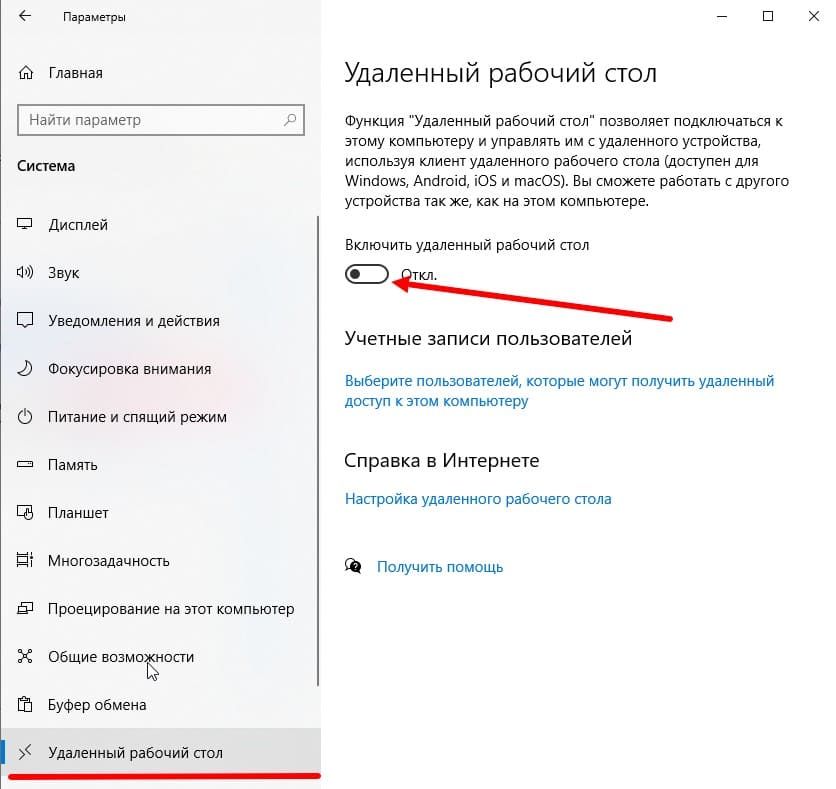
— Перейдите в настройки «Электропитание» и отключите переход компьютера в спящий режим.
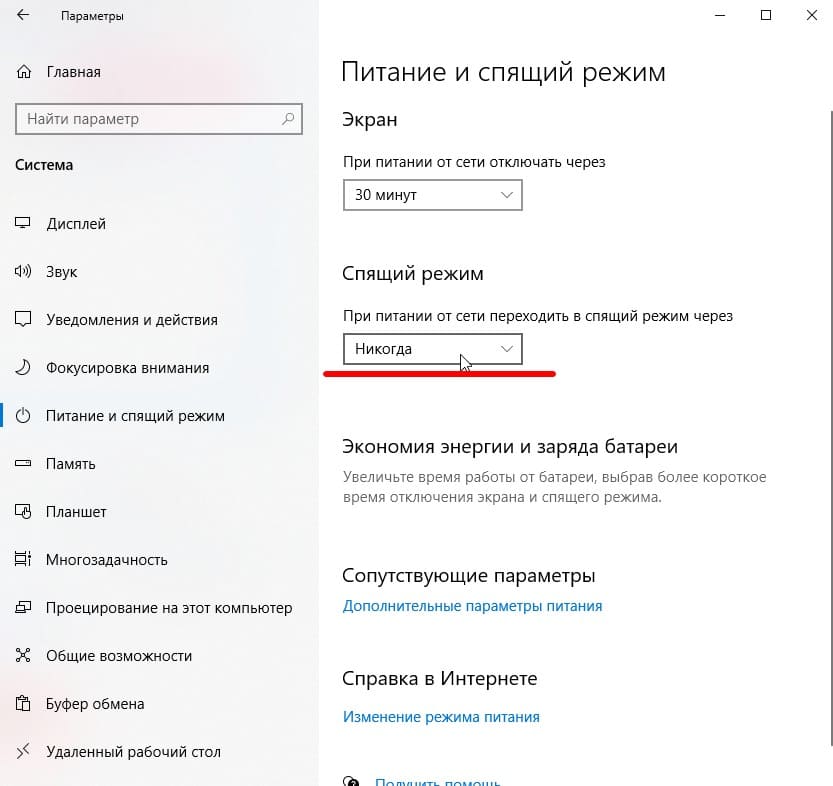
— Добавьте пользователей, которым будет предоставлен доступ к RDP. По умолчанию доступ предоставлен администратору компьютера.
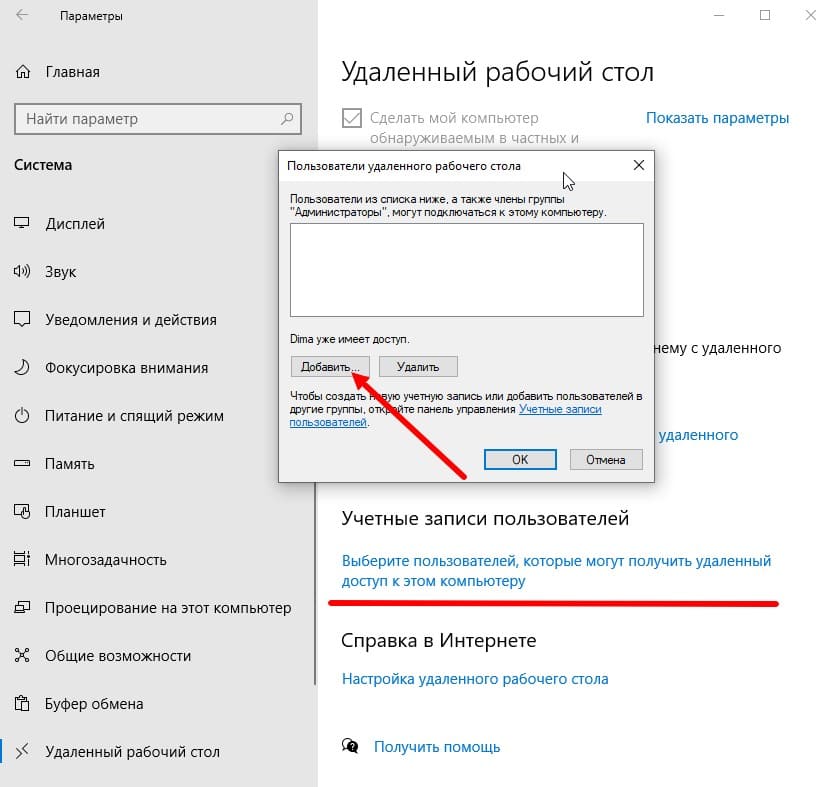
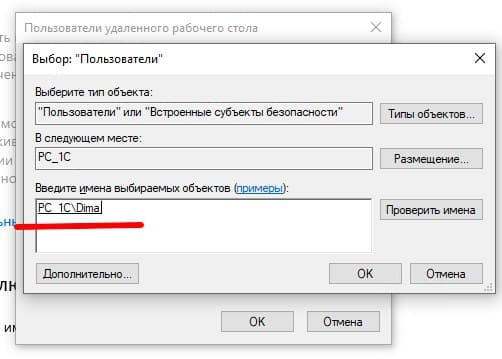
Ограничение количества одновременных подключений
Если вы попытаетесь открыть второй сеанс RDP, появится предупреждение с просьбой отключить сеанс первого пользователя.
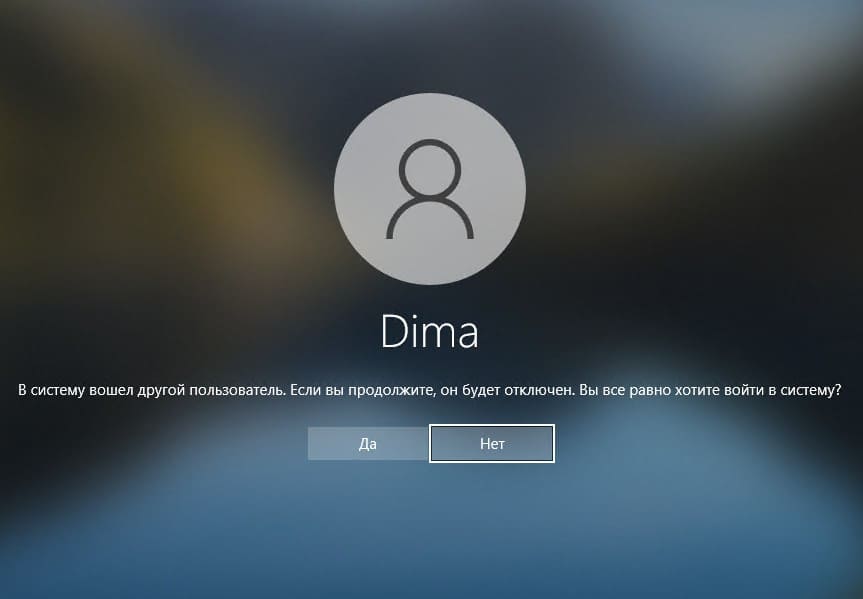
На самом деле, количество одновременных подключений RDP в системе Windows ограничено лицензией, а не техническими аспектами. Это ограничение не позволяет создать полноценный терминальный RDP-сервер на базе компьютера с Windows 10 или 11. Microsoft рекомендует использовать серверную лицензию Windows Server и RDS CALs для создания сервера сеансов удаленного рабочего стола.
Однако технически любая версия Windows с достаточным объемом оперативной памяти может поддерживать несколько удаленных пользователей. Среднее потребление памяти для одного сеанса — около 200 МБ (без учета запущенных приложений). Таким образом, максимальное количество сеансов теоретически ограничено только ресурсами компьютера.
Способы разрешить одновременные RDP-подключения в Windows 10/11:
— С помощью RDP Wrapper
— Исправление библиотеки termsrv.dll
RDP Wrapper
RDP Wrapper — это проект с открытым исходным кодом, который позволяет включить несколько сеансов RDP в Windows 10 без необходимости замены файла termsrv.dll. Этот инструмент работает как связующее звено между Service Control Manager (SCM) и службами удаленного рабочего стола, что позволяет не только поддерживать несколько одновременных RDP-сессий, но и создать RDP-сервер на Windows Home.
RDP Wrapper не вносит изменений в файл termsrv.dll, а просто загружает его с измененными параметрами, что делает его устойчивым к обновлениям Windows.
Вы можете загрузить RDP Wrapper из репозитория GitHub.
В архиве RDPWrap-v1.6.2.zip содержатся несколько файлов:
RDPWinst.exe — установщик оболочки RDP
RDPConf.exe — инструмент настройки оболочки RDP
RDPCheck.exe — утилита проверки RDP (Local RDP Checker)
Install.bat, uninstall.bat, update.bat — пакетные файлы для установки, удаления и обновления оболочки
Для установки оболочки необходимо запустить файл Install.bat с правами администратора.
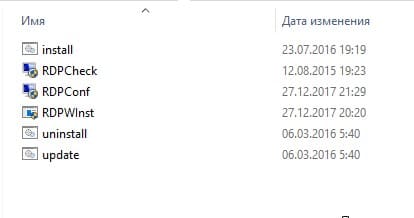
RDPWrap не работает в Windows 10
После завершения установки запустите RDPConfig.exe. Скорее всего, сразу после установки инструмент покажет, что оболочка RDP запущена (установлена, запущена), но не работает. Обратите внимание на красное предупреждение [not supported]. В нем сообщается, что эта версия Windows 10 (версия 10.0.19041.1387) не поддерживается оболочкой RDP.
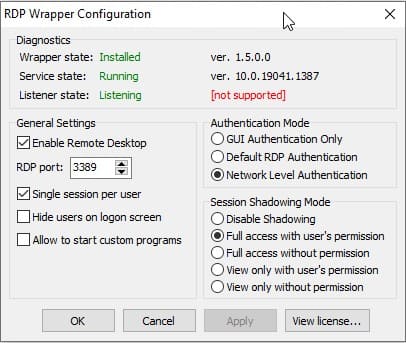
Для каждой версии Windows 10/11 должно быть описание в конфигурационном файле rdpwrap.ini. В текущем конфигурационном файле может не быть необходимых настроек для вашей сборки Windows.
Текущую версию файла rdpwrap.ini можно загрузить здесь: https://raw.githubusercontent.com/sebaxakerhtc/rdpwrap.ini/master/rdpwrap.ini
Скопируйте новый файл rdpwrap.ini в каталог C:\Program Files\RDP Wrapper\rdpwrap.ini и перезапустите службу TermService. В некоторых случаях это может не сработать, так как оригинальный файл восстанавливается при перезапуске службы. Чтобы решить эту проблему, можно использовать файл автоматического обновления rdpwrap.ini.
Скопируйте файлы RDPWinst.exe, RDPConf.exe, RDPCheck.exe и autoupdate.bat в каталог C:\Program Files\RDP Wrapper\ и запустите autoupdate.bat. После этого RDPConfig.exe должен показать, что все работает корректно.
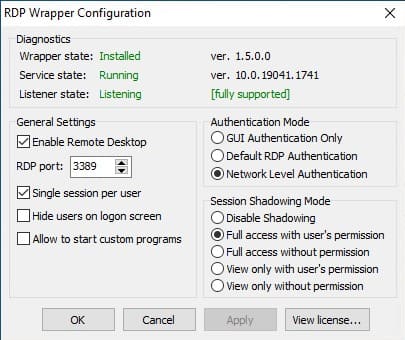
Обновление Параметров Групповой политики
Количество подключений к компьютеру может быть ограничено правилами групповой политики. В этом случае можно использовать редактор локальной групповой политики (gpedit.msc), чтобы включить политику «Ограничить количество подключений» в разделе Конфигурация компьютера -> Административные шаблоны -> Компоненты Windows -> Службы удаленных рабочих столов -> Узел сеансов удаленных рабочих столов -> Подключения -> Ограничить количество подключений. Измените значение на 999999.
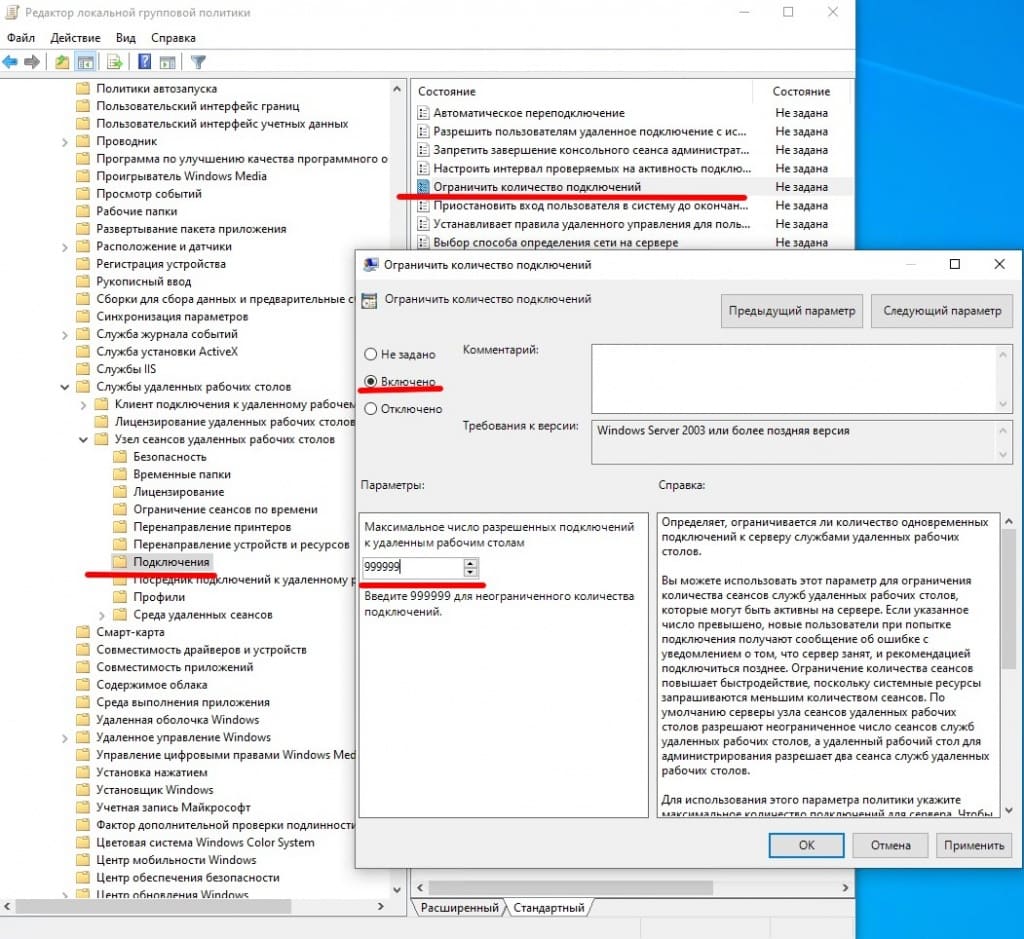
Модификация Termsrv.dll
Второй метод — это изменение файла termsrv.dll. Этот метод более трудозатратный и требует остановки службы удаленных рабочих столов (TermService), а также внесения изменений в файл с использованием шестнадцатеричного редактора (например, WinHex).
Для начала, остановите службу TermService:
Net stop TermService
Чтобы изменить владельца файла с TrustedInstaller на локальную группу администраторов, выполните команду:
takeown /F c:\Windows\System32\termsrv.dll /A
Теперь предоставьте локальной группе администраторов разрешения на полный контроль над termsrv.dll файл с использованием icacls.exe:
icacls c:\Windows\System32\termsrv.dll /grant Администраторы:F
Откройте файл termsrv.dll с использованием любого шестнадцатеричного редактора (например, WinHex. В зависимости от вашей сборки Windows вам необходимо найти и заменить строку в соответствии с приведенной ниже таблицей:
| Версия Windows | Строка поиска |
|---|---|
| Windows 11 RTM (21H2 – 22000.258) | 39 81 3C 06 00 00 0F 84 4F 68 01 00 |
| Windows 10 x64 22H2 — 19045.2604 | 39 81 3C 06 00 00 0F 84 85 45 01 00 |
| Windows 10 x64 22H2 — 19045.2486 | 39 81 3C 06 00 00 0F 84 DB 61 01 00 |
| Windows 10 x64 21H2 | 39 81 3C 06 00 00 0F 84 85 45 01 00 |
| Windows 10 x64 21H1 | 39 81 3C 06 00 00 0F 84 2B 5F 01 00 |
| Windows 10 x64 20H2 | 39 81 3C 06 00 00 0F 84 21 68 01 00 |
| Windows 10 x64 2004 | 39 81 3C 06 00 00 0F 84 D9 51 01 00 |
| Windows 10 x64 1909 | 39 81 3C 06 00 00 0F 84 5D 61 01 00 |
| Windows 10 x64 1903 | 39 81 3C 06 00 00 0F 84 5D 61 01 00 |
| Windows 10 x64 1809 | 39 81 3C 06 00 00 0F 84 3B 2B 01 00 |
| Windows 10 x64 1803 | 8B 99 3C 06 00 00 8B B9 38 06 00 00 |
| Windows 10 x64 1709 | 39 81 3C 06 00 00 0F 84 B1 7D 02 00 |
Строка замены:
B8 00 01 00 00 89 81 38 06 00 00 90
Данную таблицу можно найти в интернете. Если указанная последовательность не найдена в вашем файле, попробуйте искать начальную часть последовательности: 39 81 3C 06 00 00 0F 84, последние 4 байта могут отличаться.
В нашем случае мы нашли последовательность 39 81 3C 06 00 00 0F 84 73 55 01 00
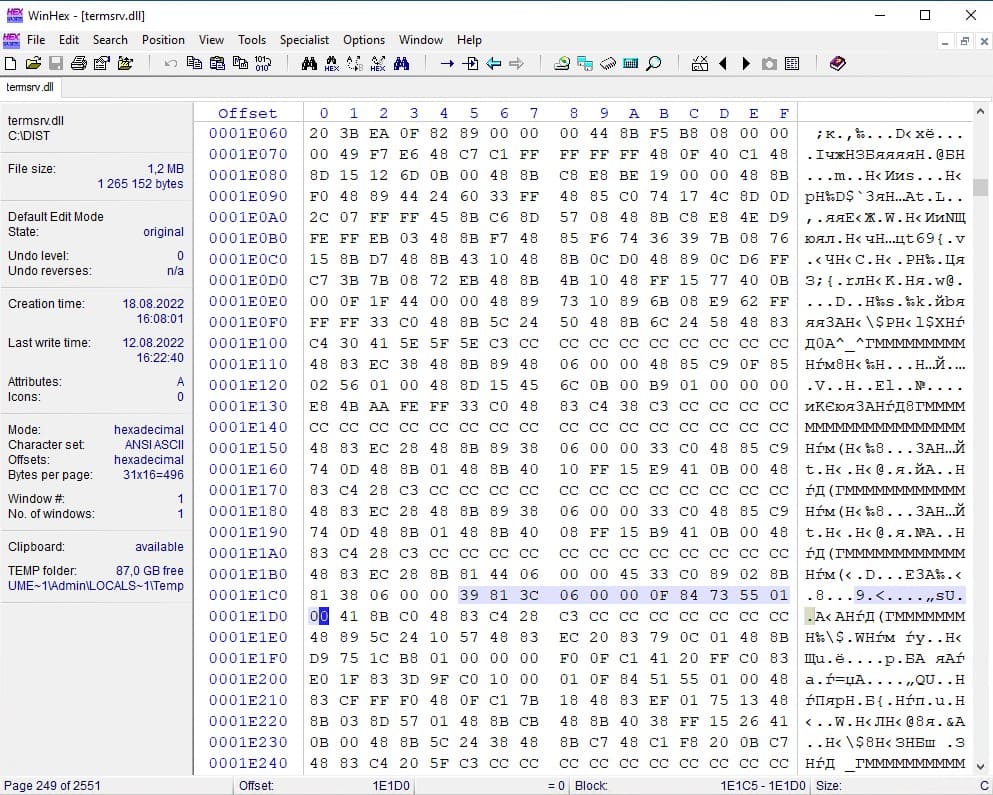
Замена на B8 00 01 00 00 89 81 38 06 00 00 90
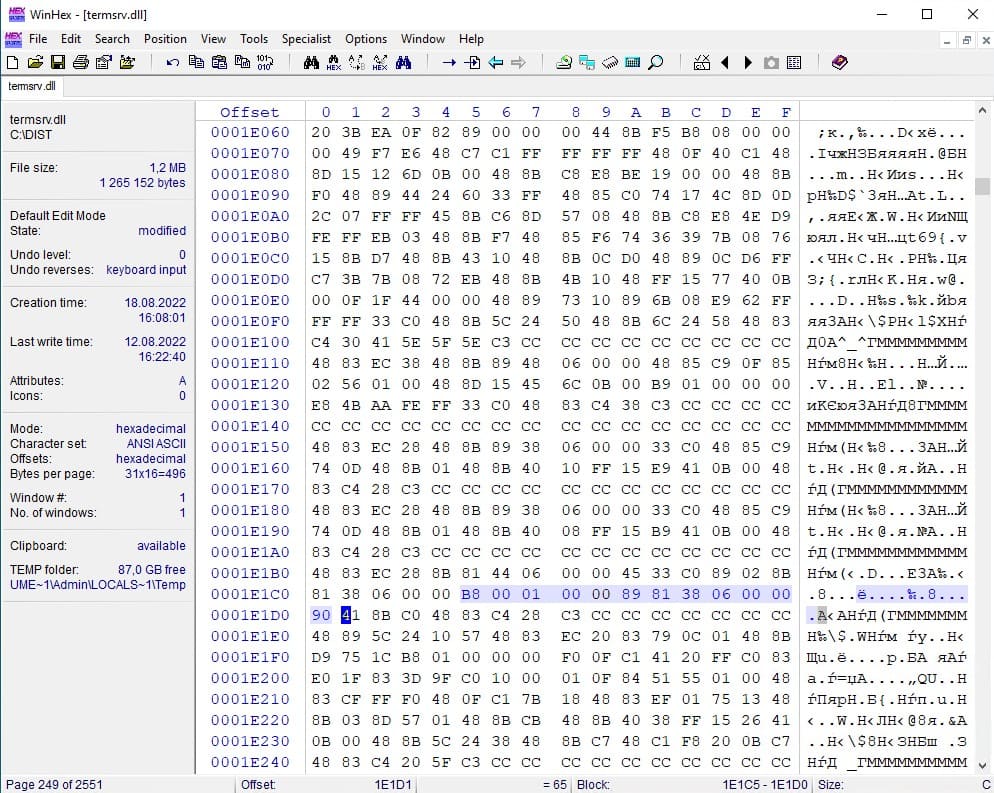
После внесения изменений сохраните модифицированный файл и запустите службу TermService:
Net start TermService
Скачать измененный файл termsrv.dll для конкретной версии Windows 10 можно у нас на сайте:
Скачать termsrv.dll для версии — Windows 10 x64 22H2 сборка 19045.2486 и 19045.2604
Скачать termsrv.dll для версии — Windows 10 x64 22H2 сборка 19045.3086
Сохраните модифицированный файл и запустите службу TermService. Если что-то пойдет не так, остановите службу и замените модифицированный файл termsrv.dll на оригинальную версию. В моем случае модификация файла помогла включить несколько сеансов RDP.
Преимущества и недостатки методов
Преимущество метода с заменой termsrv.dll заключается в том, что антивирусы не реагируют на этот файл, в отличие от RDPWrap, который многими антивирусами обнаруживается как вредоносное ПО. Основным недостатком является необходимость вручную редактировать файл при каждом обновлении сборки Windows.
Метод с RDP Wrapper проще в использовании и не требует изменения системных файлов, но также может потребовать обновления конфигурации при каждом обновлении Windows.
Удаленные пользователи могут подключаться к своим компьютерам Windows 10 через службу удаленных рабочих столов (RDP) в редакциях Pro и Enterprise (но не в Home/Single Language). Но есть ограничение на количество одновременных RDP сессии – допускается одновременная работа только одного удаленного пользователя. Если вы попробуете открыть вторую RDP сессию, появится предупреждение с запросом отключить сеанс первого пользователя.
Данная информация предназначена для услуг: VPS хостинг или Облачный хостинг
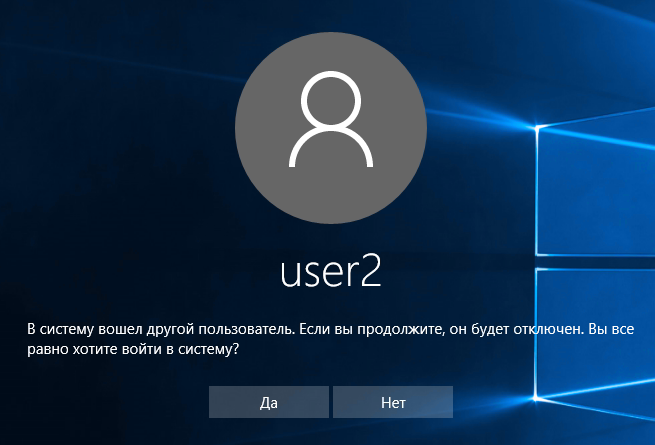
В систему вошел другой пользователь. Если вы продолжите, он будет отключен. Вы все равно хотите войти в систему?
В английской версии предупреждение такое:
Another user is signed in. If you continue, they’ll be disconnected. Do you want to sign in anyway?
Рассмотрим основные ограничения на использование службы удаленного рабочего стола в Windows 10 (и всех предыдущих десктопных версиях Windows):
- Вы можете удаленно подключиться через RDP только к старшим редакциям Windows (Professional и выше). В домашних редакциях (Home) RDP доступ заблокирован.
- Поддерживается только одно одновременное RDP подключение. При попытке запустить вторую RDP-сессию, пользователю предлагается завершить существующее подключение.
- Если пользователь работает за консолью компьютера (локально), то при удаленном подключении по RDP, его локальный сеанс будет отключен (заблокирован). Правильно и обратное утверждение: удаленный RDP сеанс принудительно завершается, если пользователь авторизуется на консоли системы.
Ограничение на количество одновременных RDP подключений является не техническим, а скорее лицензионным. Таким образом Microsoft запрещает создавать терминальный RDP сервер на базе рабочей станции для одновременной работы нескольких пользователей. Логика Microsoft проста: если вам нужен терминальный сервер — купите лицензию Windows Server, лицензии RDS CAL, установите и настройте роль Remote Desktop Session Host (RDSH).
Хотя с технической точки зрения любая редакция Windows при наличии достаточного количества оперативной памяти может обслуживать одновременную работу нескольких десятков удаленных пользователей. В среднем на одну RDP сессию пользователя без учета запускаемых приложений требуется 150-200 Мб памяти. Т.е. максимальное количество одновременных RDP сессий в теории ограничивается только ресурсами компьютера.
Мы рассмотрим два способа отключить ограничение на количество одновременных RDP подключений к Windows 10: с помощью приложения RDP Wrapper и с помощью правки файла termsrv.dll.
Важно. Изначально в самой первой версии статьи основным рабочим вариантом, позволяющим снять ограничение на количество одновременных RDP подключений пользователей в Windows был способ модификации и подмены файла termsrv.dll в папке %SystemRoot%\System32. Однако при установке нового билда Windows 10 или некоторых обновлений безопасности, этот файл обновляется.
В результате приходится каждый раз редактировать этот файл Hex редактором, что довольно утомительно. Поэтому в качестве основного способа организации бесплатного терминального сервера на клиентской Windows 10 стоит считать утилиту RDP Wrapper Library.
Примечание. Модификации системы, описанные в этой статье, считаются нарушением лицензионного соглашения Windows и вы можете выполнять их на свой страх и риск.
RDP Wrapper: разрешить несколько RDP сеансов в Windows 10
OpenSource проект RDP Wrapper Library позволяет включить конкурентные RDP сессии в Windows 10 без замены файла termsrv.dll. Эта программа работает в качестве прослойки между менеджером управления службами (SCM — Service Control Manager) и службой терминалов (Remote Desktop Services). RDPWrap позволяет включить не только поддержку нескольких одновременных RDP сессии, но и реализовать RDP сервер на домашних редакциях Windows 10. RDP Wrapper не вносит никаких изменений в файл termsrv.dll, просто подгружая termsrv с изменёнными параметрами.
Таким образом, RDPWrap будет работать даже при обновлении версии файла termsrv.dll, что позволяет не опасаться обновлений Windows.
Важно. Перед установкой RDP Wrapper важно убедится, чтобы у вас использовалась оригинальная (непропатченная) версия файл termsrv.dll. В противном случае RDP Wrapper может работать не стабильно, или вообще не запускаться.
Вы можете скачать RDP Wrapper из репозитория GitHub: https://github.com/binarymaster/rdpwrap/releases (последняя доступная версия RDP Wrapper Library v1.6.2). Судя по информации на странице разработчика, поддерживаются все версии Windows. Windows 10 поддерживается вплоть до 1809 (хотя в 1909 тоже все прекрасно работает, см. ниже).
Архив RDPWrap-v1.6.2.zip содержит несколько файлов:
- RDPWinst.exe —программа установки/удаления RDP Wrapper Library;
- RDPConf.exe — утилита настройки RDP Wrapper;
- RDPCheck.exe — Local RDP Checker — утилита проверки RDP;
- install.bat, uninstall.bat, update.bat — пакетные файлы для установки, удаления и обновления RDP Wrapper.
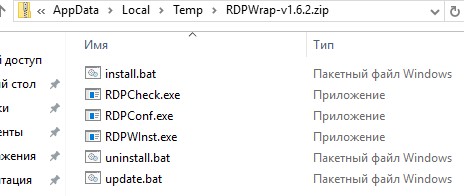
Чтобы установить RDPWrap, запустите файл install.bat с правами администратора.
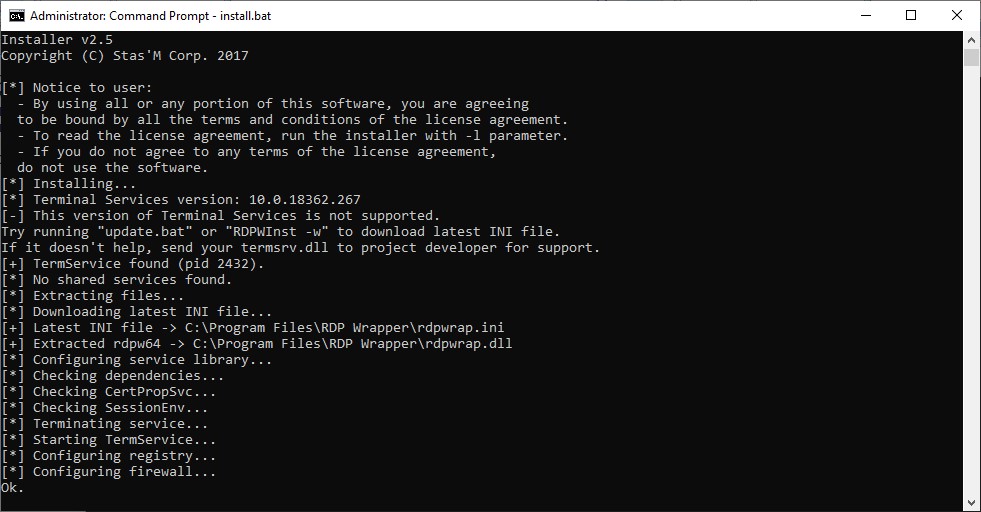
После окончания установки запустите RDPConfig.exe. Проверьте, что в секции Diagnostics все элементы окрашены в зеленый цвет.
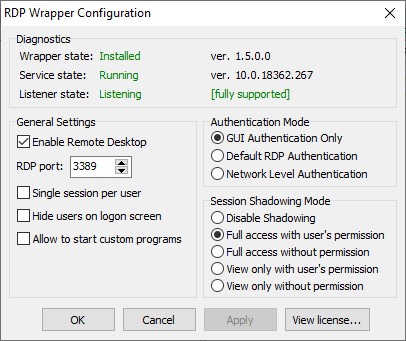
Запустите RDPCheck.exe и попробуйте открыть вторую RDP сессию (или подключитесь несколькими сессиями RDP с удаленных компьютеров) Все получилось! Теперь ваша Windows 10 позволяет одновременно подключаться по RDP сразу двум удаленным пользователям.
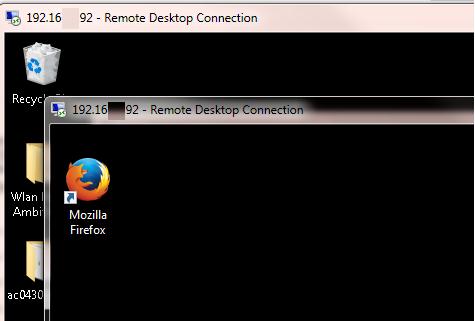
Утилита RDPWrap поддерживается во редакциях Windows: Windows Vista, Windows 7, Windows 8, Windows 8.1 и Windows 10. Таким образом из любой клиентской версии Windows можно сделать сервер терминалов.
Также из интересных возможностей RDP Wrapper можно выделить:
- Опция Hide users on logon screen позволяет скрыть список пользователей на экране приветствия;
- При отключении опции Single session per user — будут разрешены несколько одновременных RDP сессий под одной учетной записью (устанавливается параметр реестра fSingleSessionPerUser = 0 в ветке HKLM\SYSTEM\ CurrentControlSet\Control\Terminal Server\fSingleSessionPerUser).
- RDP Port — можно изменить номера порта удаленного рабочего стола со стандартного TCP 3389 на любой другой;
- В секции Session Shadowing Mode вы можете выбрать режим теневого подключения к рабочему столу пользователей Windows 10.
Не работает RDP Wrapper в Windows 10
Рассмотрим, что делать, если у вас в Windows 10 при установленной утилите RDP Wrapper не получается использовать несколько RDP подключений..
В моем случае утилита RDConfig в окне статуса показывала [not supported]. Проблема была в том, что на компьютере отсутствовал прямой доступ в Интернет и программа не смогла скачать с GitHub актуальную версию файла rdpwrap.ini с настройками для последних версий Windows (как вручную обновить rdpwrap.ini см. ниже).
Скачайте файл rdpwrap.ini с ресурса разработчика и поместите его в каталог установки (C:\Program Files\RDP Wrapper\rdpwrap.ini). Перезапустите службу TermService и убедитесь, что надпись [not supported] сменилась на [fully supported].
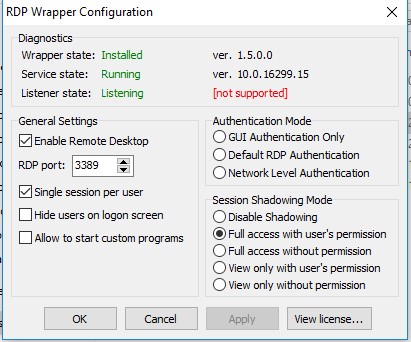
Чтобы заменить файл rdpwrap.ini:
- Остановите службу termservice:
get-service termservice|stop-service - Замените файл rdpwrap.ini в каталоге C:\Program Files\RDP Wrapper\;
- Перезагрузите компьютер;
- После перезагрузки запустите RDPConf и убедитесь, что все статусы стали зелеными.
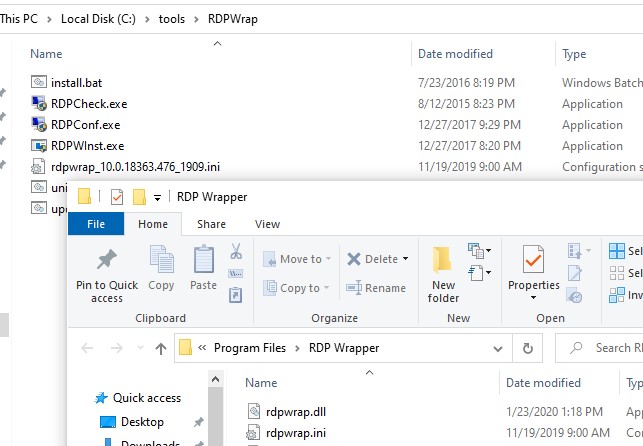
Если после установки обновлений безопасности или после апгрейда билда Windows 10, RDP Wrapper не работает, проверьте, возможно в секции Diagnostics присутствует надпись Listener state: Not listening.
Попробуйте обновить ini файл «C:\Program Files\RDP Wrapper\rdpwrap.ini» скриптом update.bat (либо вручную) и переустановить службу:
rdpwinst.exe -u
rdpwinst.exe -i
Бывает, что при попытке второго RDP подключения под другим пользователем у вас появляется надпись:
Число разрешенных подключений к этому компьютеру ограничено и все подключений уже используются. Попробуйте подключиться позже или обратитесь к системному администратору.
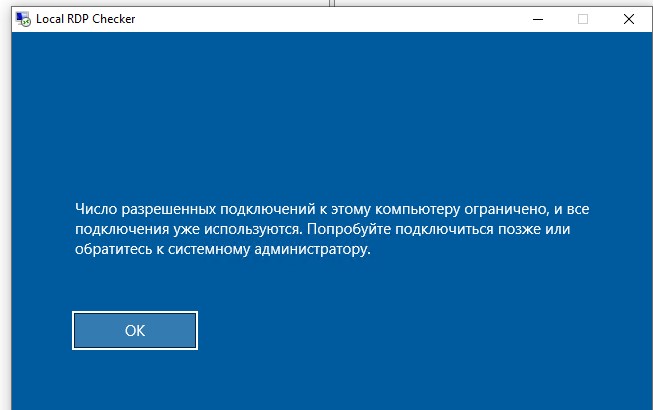
The number of connections to this computer is limited and all connections are in use right now. Try connecting later or contact your system administrator.
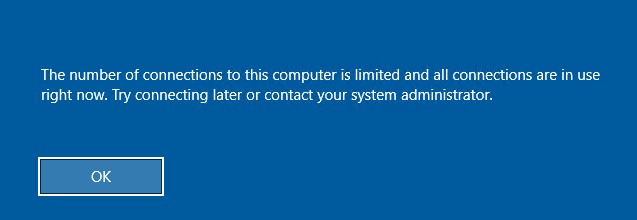
В этом случае нужно с помощью редактора групповых политики gpedit.msc в секции Конфигурация компьютера –> Административные шаблоны -> Компоненты Windows -> Службы удаленных рабочих столов -> Узел сеансов удаленных рабочих столов -> Подключения включить политику “Ограничить количество подключений” и изменить ее значение на 999999 (Computer Configuration -> Administrative Templates -> Windows Components ->Remote Desktop Services ->Remote Desktop Session Host -> Connections-> Limit number of connections).
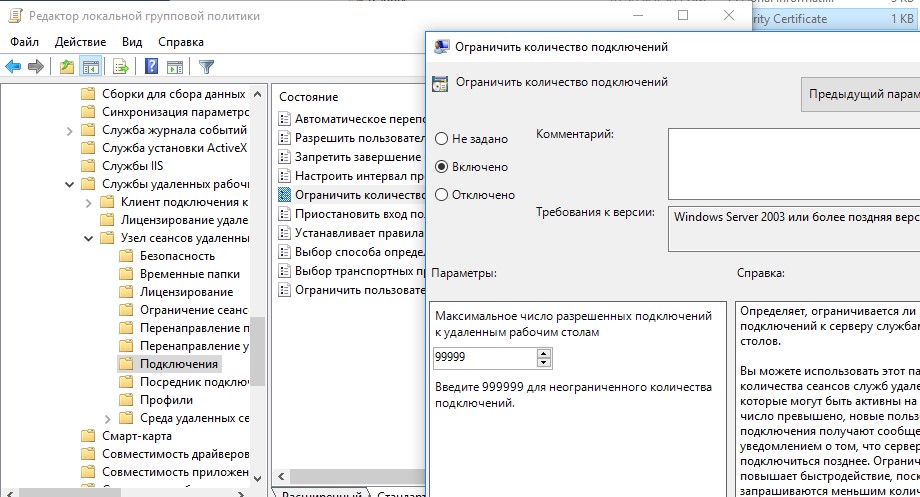
Перезагрузите компьютер для применения настроек.
Модификация файла termsrv.dll для снятия ограничений RDP в Windows 10
Чтобы убрать ограничение на количество RDP подключений пользователей в Windows 10 без использования rdpwraper, можно заменить файл termsrv.dll. Это файл библиотеки, которая используется службой Remote Desktop Services. Файл находится в каталоге C:\Windows\System32.
Прежде, чем править или заменять файл termsrv.dll желательно создать его резервную копию. Это поможет вам в случае необходимости можно будет вернуться к исходной версии файла. Запустите командную строку с правами администратора и выполните команду:
copy c:\Windows\System32\termsrv.dll termsrv.dll_backup

Прежде чем править файл termsrv.dll, вам нужно стать его владельцем и предоставить группе администраторов полные права на него. Проще всего это сделать из командной строки. Чтобы сменить владельца файла с TrustedInstaller на группу локальных администраторов с помощью команды:
takeown /F c:\Windows\System32\termsrv.dll /A
Должно появится сообщение: «SUCCESS: The file (or folder): «c:\Windows\System32\termsrv.dll» now owned by the administrators group».
Теперь предоставим группе локальных администраторов полные права на файл termsrv.dll (Full Control):
icacls c:\Windows\System32\termsrv.dll /grant Administrators:F (или Администраторы в русской версии Windows). Должно появится сообщение: «processed file: c:\Windows\System32\termsrv.dll Successfully processed 1 files; Failed processing 0 files«.

Теперь нужно остановить службу Remote Desktop Service (TermService) из консоли services.msc или из командной строки:
Net stop TermService
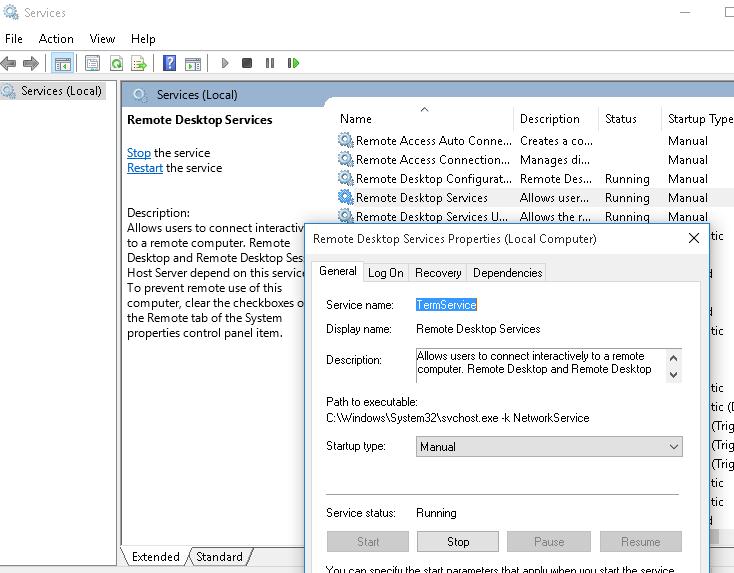
Прежде чем идти дальше, вам нужно узнать вашу версию (билд) Windows 10. Проще всего это сделать с помощью следующей команды PowerShell:
Get-ComputerInfo | select WindowsProductName, WindowsVersion
В моем случае установлена Windows 10 билд 1909.
Затем откройте файл termsrv.dll с помощью любого HEX редактора (к примеру, Tiny Hexer). В зависимости от билда нужно найти и заменить строку:
| Версия Windows 10 | Найти строку | Заменить на |
| Windows 10 x64 1909 | 39 81 3C 06 00 00 0F 84 5D 61 01 00 |
B8 00 01 00 00 89 81 38 06 00 00 90 |
| Windows 10 x64 1903 | 39 81 3C 06 00 00 0F 84 5D 61 01 00 | |
| Windows 10 x64 1809 | 39 81 3C 06 00 00 0F 84 3B 2B 01 00 | |
| Windows 10 x64 1803 | 8B 99 3C 06 00 00 8B B9 38 06 00 00 | |
| Windows 10 x64 1709 | 39 81 3C 06 00 00 0F 84 B1 7D 02 00 |
Например, для самой первой редакции Windows 10 x64 RTM 10240 (версия файла termsrv.dll — 10.0.10240.16384) нужно открыть файл termsrv.dll в Tiny Hexer. Затем найдите строку:
39 81 3C 06 00 00 0F 84 73 42 02 00
И замените ее на:
B8 00 01 00 00 89 81 38 06 00 00 90
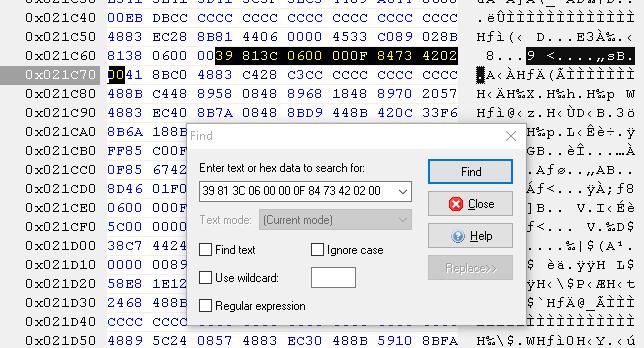
Сохраните файл и запустите службу TermService.
Готовый пропатченный файл termsrv.dll для Windows 10 Pro RTM x64 можно скачать здесь: termsrv_windows_10_x64_10240.zip
Если что-то пошло не так, и у вас возникнут проблемы со службой RDP, остановите службу и замените модифицированный файл termsrv.dll исходной версией:
copy termsrv.dll_backup c:\Windows\System32\termsrv.dll
Преимущество способа включения нескольких RDP сессий в Windows 10 путем замены файла termsrv.dll в том, что на него не реагируют антивирусы. В отличии от утилиты RDPWrap, которую многие антивирусов считают Malware/HackTool/Trojan. Основной недостаток — вам придется вручную править файл при каждом обновлении билда Windows 10 (или при обновлении версии файла termsrv.dll в рамках ежемесячных кумулятивных обновлений).
Remote users can connect to their Windows 10 and 11 computers through the Remote Desktop Services (RDP). All you need to do is enable Remote Desktop, grant the user RDP access permissions, and connect to the computer using any remote desktop client. However, the number of concurrent RDP sessions is limited in desktop versions of Windows. Only one active Remote Desktop user session is allowed.
A warning will appear asking you to disconnect the first user’s session if you try to establish a second RDP connection.
Another user is signed in. If you continue, they’ll be disconnected. Do you want to sign in anyway?
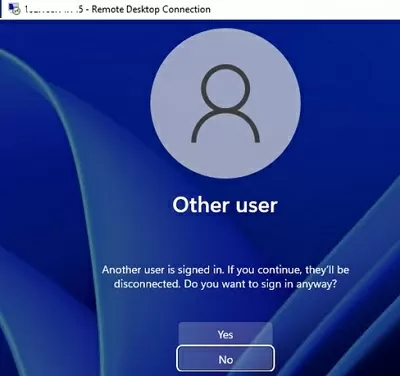
Contents:
- Number of Concurrent RDP Connections on Windows
- RDP Wrapper: Enable Multiple RDP Sessions on Windows
- RDP Wrapper Not Working on Windows
- Patch the Termsrv.dll to Enable Multiple Remote Desktop Sessions
- Multiple Concurrent RDP Connections in Windows 10 Enterprise Multi-session
Number of Concurrent RDP Connections on Windows
There are several restrictions on the use of Remote Desktop Services in all desktop versions of Windows 10 and 11:
- Only Windows Professional and Enterprise editions can accept remote desktop connections. RDP access is not allowed to Home/Single Language Windows editions;
- Only one simultaneous RDP connection is available. Attempting to start a second RDP session will prompt the user to end the active session;
- If the user is working at the computer console (locally), their local session is disconnected (locked) when they make a remote RDP connection. The remote RDP session will also be terminated if the user logs into Windows from the computer’s console.
The number of concurrent RDP connections on Windows is a license limitation. Microsoft prohibits the creation of a workstation-based Terminal RDP server for multiple users to work simultaneously.
If your tasks require the deployment of a terminal server, Microsoft suggests purchasing a Windows Server (allows two simultaneous RDP connections by default). If you need more concurrent user sessions, you will need to purchase RDS CALs, install, and configure the Remote Desktop Session Host (RDSH) role, or deploy an RDS farm.
Technically, any version of Windows with sufficient RAM and CPU resources can support dozens of remote user sessions simultaneously. On average, an RDP user session requires 150-200MB of memory (excluding running apps). This means that the maximum number of concurrent RDP sessions is limited only by the available resources of the computer.
In this article, we are going to show you three ways to remove the limit on the number of concurrent RDP connections in Windows 10 and 11:
- RDP Wrapper
- Modifying the termsrv.dll file
- Upgrading Windows 10/11 edition to Enterprise for virtual desktops (multi-session)
Note. Any modifications to the operating system that are described in this article are considered a violation of the Windows License Agreement and may be used at your own risk.
Before you proceed, make sure that the Remote Desktop protocol is enabled in Windows.
- Go to Settings -> System —> Remote Desktop -> Enable Remote Desktop;
- Or use the classic Control Panel: run the command
SystemPropertiesRemoteand check the option Allow remote connection to this computer.
RDP Wrapper: Enable Multiple RDP Sessions on Windows
The RDP Wrapper Library OpenSource project allows you to enable multiple RDP sessions on Windows 10/11 without replacing the termsrv.dll file. This tool acts as a layer between SCM (Service Control Manager) and the Remote Desktop Services. The RDP wrapper doesn’t make any changes to the termsrv.dll file, it simply loads the termsrv with the modified settings.
Thus, the RDPWrap will work even in the case of termsrv.dll file update. It allows you not to be afraid of Windows updates.
Important. Before installing the RDP Wrapper, it is important to make sure that you are using the original (unpatched) version of the termsrv.dll file. Otherwise, the RDP Wrapper may become unstable or not start at all.
You can download the RDP Wrapper from the GitHub repository https://github.com/binarymaster/rdpwrap/releases (the latest available version of the RDP Wrapper Library is v1.6.2). The project hasn’t been updated since 2017, but it can be used in all new builds of Windows 10 and 11. To use the wrapper on modern versions of Windows, simply update the rdpwrap.ini configuration file.
RDP Wrapper is detected as a potentially dangerous program by most antivirus scanners. For example, it is classified as PUA:Win32/RDPWrap (Potentially Unwanted Software) with a low threat level by the built-in Microsoft Defender antivirus. If your antivirus settings are blocking the RDP Wrapper from starting, you will need to add it to the exceptions.
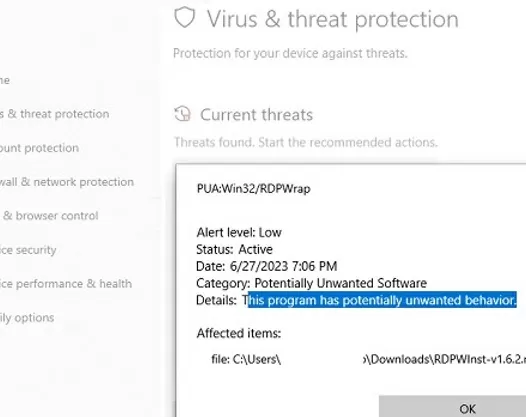
The RDPWrap-v1.6.2.zip archive contains some files:
- RDPWinst.exe — used to install/uninstall an RDP wrapper library;
- RDPConf.exe — RDP Wrapper configuration tool;
- RDPCheck.exe —an RDP check tool (Local RDP Checker);
- install.bat, uninstall.bat, update.bat — batch files to install, uninstall, and update RDP Wrapper.
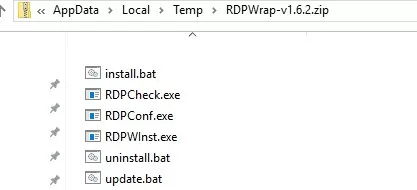
To install RDPWrap, run the install.bat file as an administrator. The program is installed in the C:\Program Files\RDP Wrapper directory.
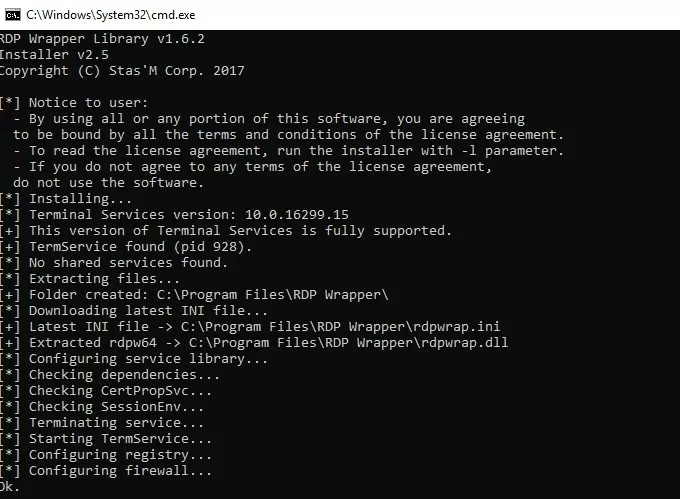
Run RDPConfig.exe when the installation is complete.
Most likely, immediately after installation, the tool will show that the RDP wrapper is running (Installed, Running, Listening), but not working. Note the red [not supported] warning. It reports that this version of Windows 10 22H2 (ver. 10.0.19041.1949) is not supported by the RDPWrapper.
This is because the rdpwrap.ini configuration file does not contain settings for your Windows version (build). +
✅ Download the latest version of rdpwrap.ini here https://raw.githubusercontent.com/sebaxakerhtc/rdpwrap.ini/master/rdpwrap.ini
Manually copy the contents of this page into the C:\Program Files\RDP Wrapper\rdpwrap.ini file. Or download the INI file using the PowerShell cmdlet Invoke-WebRequest (you must first stop the Remote Desktop service):
Stop-Service termservice -Force
Invoke-WebRequest https://raw.githubusercontent.com/sebaxakerhtc/rdpwrap.ini/master/rdpwrap.ini -outfile "C:\Program Files\RDP Wrapper\rdpwrap.ini"
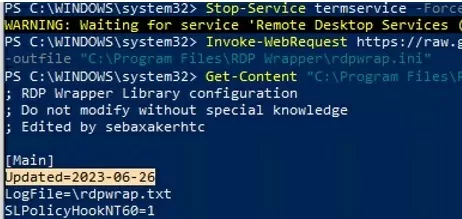
You can create a scheduled task to check for changes to rdpwrap.ini and update it automatically.
This screenshot shows that the latest version of the rdpwrap.ini file (Updated=2023-06-26) is used on the computer.
Restart your computer and run the RDPConfig.exe tool. Check that all items in the Diagnostics section are green and that the [Fully supported] message is displayed. The RDP wrapper started successfully on Windows 11 22H2 in my case.
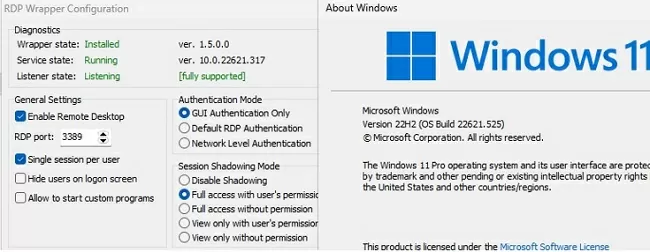
Now try to establish several concurrent RDP sessions with this computer under different user accounts (use your favorite RDP client: mstsc.exe, RDCMan, mRemoteNG, etc).
You can check that two (or more) RDP sessions are active on the computer at the same time by using the command:
qwinsta
rdp-tcp#0 user1 1 Active rdp-tcp#1 user2 2 Active
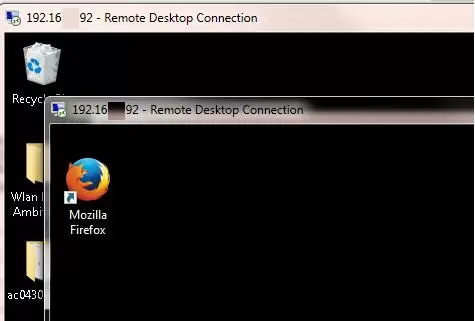
The RDPWrap tool is supported in all Windows editions, so you can build your own terminal (RDS) server on any Windows device. So you can turn any version of Windows client into a full-featured terminal server.
The following options are available in the RDP Wrapper:
- Enable Remote Desktop
- RDP Port —change the default remote desktop port number (TCP 3389)
- Hide users on logon screen – allow hiding the list of users from the Windows Logon Screen;
- Single session per user — allow several concurrent RDP sessions under the same user account. This option sets the fSingleSessionPerUser registry value to 0 (
HKLM\SYSTEM\ CurrentControlSet\Control\Terminal Server\fSingleSessionPerUser). This parameter is also configured through the GPO option Restrict Remote Desktop Services to a single Remote Desktop Services session under Computer Configuration > Administrative Templates > Windows Components > Remote Desktop Services > Remote Desktop Session Host > Connections; - The Session Shadowing Mode allows you to configure the remote control (shadow) connection mode to the RDP users’ desktops
RDP Wrapper Not Working on Windows
In some cases, the RDP Wrapper may not work as you expect it to and you may not be able to use more than one RDP connection on Windows.
The termsrv.dll file version can be updated during Windows Updates installation. If the description for your version of Windows is missing from the rdpwrap.ini file, then the RDP Wrapper will not be able to apply the necessary settings. In this case, the status [not supported]. will be displayed in the RDP Wrapper Configuration window.
✅ In this case, you must update the rdpwrap.ini file as described above.
If RDP Wrapper does not work after updating the rdpwrap.ini file, try to open the rdpwrap.ini file and look for the section for your version of Windows.
How to understand if your Windows version is supported in rdpwrapper config?
The screenshot below shows that for my version of Windows 11 (10.0.22621.317) there are two sections of settings:
[10.0.22621.317] ... [10.0.22621.317-SLInit] ...
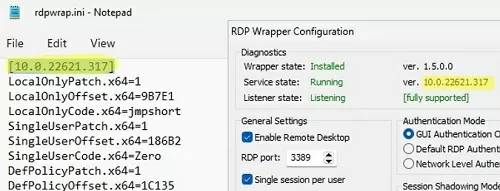
If there is no section in the rdpwrap configuration file for your version of Windows, try searching the web for the rdpwrap.ini file. Add the configuration settings you found to the end of the file.
If the RDP Wrapper does not work after you install security updates or upgrade the Windows build, check that there is no Listener state: Not listening warning in the RDPWrap Diagnostics section.
Try updating the rdpwrap.ini file, and then reinstalling the rdpwrapper service:
rdpwinst.exe -u
rdpwinst.exe -i
It can happen that when you try to make a second RDP connection as a different user, you will get an error message:
The number of connections to this computer is limited and all connections are in use right now. Try connecting later or contact your system administrator.
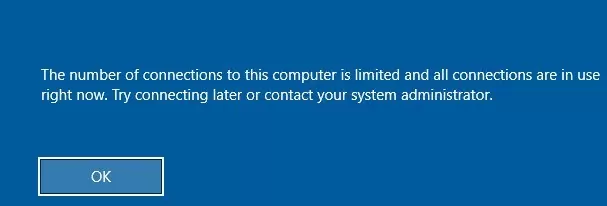
In this case, you can use the local Group Policy Editor (gpedit.msc) to enable the “Limit number of connections” option under Computer Configuration -> Administrative Templates -> Windows Components -> Remote Desktop Services -> Remote Desktop Session Host -> Connections section. Increase the ‘RD maximum connection allowed’ value to 999999.
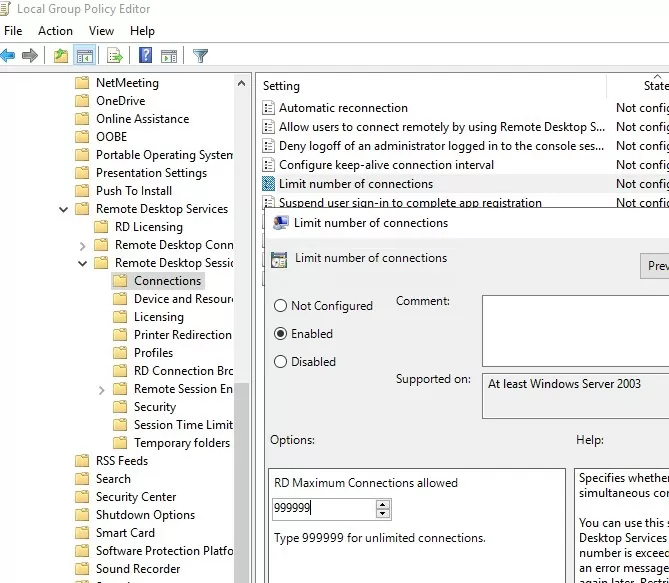
Restart your computer to update the local Group Policy and apply the settings.
Patch the Termsrv.dll to Enable Multiple Remote Desktop Sessions
To remove the limit on the number of concurrent RDP user connections in Windows without using rdpwrapper, you can replace the original termsrv.dll file. This is the main library file used by the Remote Desktop Service. The file is located in the C:\Windows\System32 directory.
It is advisable to make a backup copy of the termsrv.dll file before editing or replacing it. This will help you to revert to the original version of the file if necessary. Open an elevated command prompt and run the command:
copy c:\Windows\System32\termsrv.dll termsrv.dll_backup
Then you need to take ownership of the termsrv.dll file. To change a file’s owner from TrustedInstaller to the local Administrators group, use the command:
takeown /F c:\Windows\System32\termsrv.dll /A
SUCCESS: The file (or folder): c:\Windows\System32\termsrv.dll now owned by the administrators group
Now use the icacls.exe tool to grant Full Control permissions to the termsrv.dll file for the local Administrators group:
icacls c:\Windows\System32\termsrv.dll /grant Administrators:F
processed file: c:\Windows\System32\termsrv.dll Successfully processed 1 files; Failed processing 0 files.

Now you need to stop the Remote Desktop service (TermService) using the services.msc console or with the command:
net stop TermService
It also stops the Remote Desktop Services UserMode Port Redirector service.
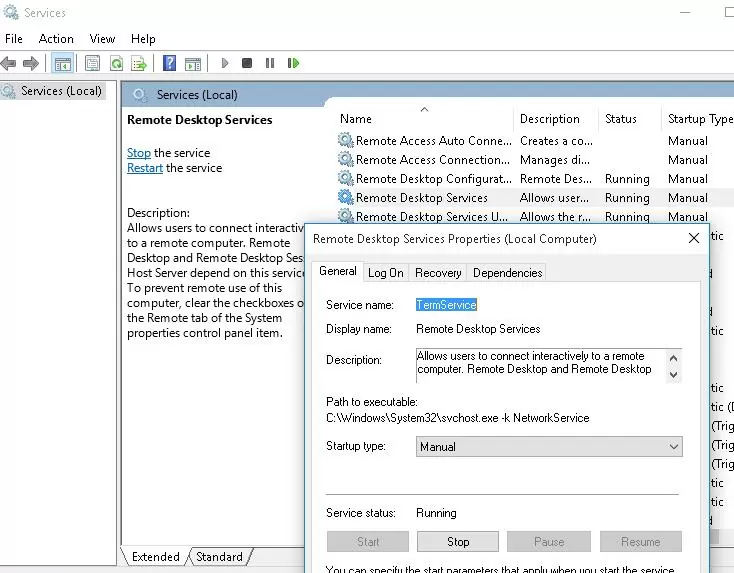
Run the winver command or the following PowerShell command to find your Windows build number:
Get-ComputerInfo | select WindowsProductName, WindowsVersion
In my case, Windows 10 build 22H2 is installed.
Then open the termsrv.dll file using any HEX editor (for example, Tiny Hexer). Depending on the build of Windows you are using, you will need to find and replace the string according to the table below:
| Windows build | Find the string | Replace with |
| Windows 11 22H2 | 39 81 3C 06 00 00 0F 84 75 7A 01 00 |
B8 00 01 00 00 89 81 38 06 00 00 90 |
| Windows 10 22H2 | 39 81 3C 06 00 00 0F 84 85 45 01 00 | |
| Windows 11 21H2 (RTM) | 39 81 3C 06 00 00 0F 84 4F 68 01 00 | |
| Windows 10 x64 21H2 | 39 81 3C 06 00 00 0F 84 DB 61 01 00 | |
| Windows 10 x64 21H1 | 39 81 3C 06 00 00 0F 84 2B 5F 01 00 | |
| Windows 10 x64 20H2 | 39 81 3C 06 00 00 0F 84 21 68 01 00 | |
| Windows 10 x64 2004 | 39 81 3C 06 00 00 0F 84 D9 51 01 00 | |
| Windows 10 x64 1909 | 39 81 3C 06 00 00 0F 84 5D 61 01 00 | |
| Windows 10 x64 1903 | 39 81 3C 06 00 00 0F 84 5D 61 01 00 | |
| Windows 10 x64 1809 | 39 81 3C 06 00 00 0F 84 3B 2B 01 00 | |
| Windows 10 x64 1803 | 8B 99 3C 06 00 00 8B B9 38 06 00 00 | |
| Windows 10 x64 1709 | 39 81 3C 06 00 00 0F 84 B1 7D 02 00 |
Tiny Hexer cannot edit termsvr.dll file directly from the system32 folder. Copy it to your desktop and replace the original file after modifying it.
For example, my build of Windows 10 x64 is 22H2 19045.2006 (termsrv.dll file version is 10.0.19041.1949). Open the termsrv.dll file in Tiny Hexer, then find the text:
39 81 3C 06 00 00 0F 84 75 7A 01 00
and replace it with:
B8 00 01 00 00 89 81 38 06 00 00 90
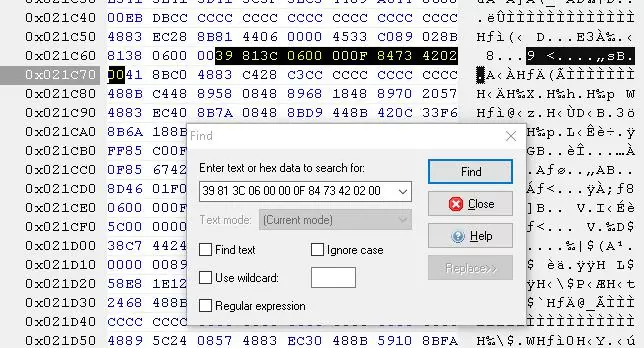
Save the file and start the TermService.
If something goes wrong and you experience some problems with the Remote Desktop service, stop the service and replace the modified termsrv.dll file with the original version:
copy termsrv.dll_backup c:\Windows\System32\termsrv.dll
To avoid manually editing the termsrv.dll file with a HEX editor, you can use the following PowerShell script to automatically patch the termsrv.dll file. The PowerShell script code is available in my GitHub repository at the following link:
https://github.com/maxbakhub/winposh/blob/main/termsrv_rdp_patch.ps1
This script was written for the Windows PowerShell version and does not work in modern PowerShell Core.
👍 The advantage of the method of enabling multiple RDP sessions in Windows 10 or 11 by replacing the termsrv.dll file is that antivirus software will not react to it (unlike RDPWrap, which is detected by many antivirus products as a malware/hack tool/trojan).
👎The disadvantage of this is that you will have to manually edit the file each time you update the Windows build (or if the monthly cumulative patches update the version of termsrv.dll).
Multiple Concurrent RDP Connections in Windows 10 Enterprise Multi-session
Microsoft has recently released a special edition of the operating system called Windows Enterprise Multi-Session (Previously known as Windows 10 Enterprise for Remote Sessions and Windows 10 Enterprise for Virtual Desktops)
The key feature of this edition is that it supports multiple concurrent RDP user sessions out of the box. Although the Windows multi-session edition is only allowed to be run in Azure VMs, you can install this edition on an on-premises network and use that computer as a terminal server (even though this would be against Microsoft’s licensing policies).
The Enterprise Multi-Session edition is available for both Windows 10 and Windows 11.
Next up, we’re going to show you how to upgrade a Windows 10 Pro edition to Windows 10 Enterprise for Virtual Desktop and use it for multiple RDP users simultaneously.
Open a command prompt and check your current edition of Windows (Professional in this example):
DISM /online /Get-CurrentEdition
Upgrade your edition of Windows 10 from Pro to Enterprise with the command:
changepk.exe /ProductKey NPPR9-FWDCX-D2C8J-H872K-2YT43
Now install the GVLK key for Windows 10 Enterprise for Remote Sessions:
slmgr.vbs /ipk CPWHC-NT2C7-VYW78-DHDB2-PG3GK
Check that your edition of Windows 10 has now changed to ServerRdsh (Windows 10 Enterprise for Virtual Desktops).

Activate your copy of Windows 10 Enterprise Multi-Session edition on your KMS server:
slmgr /skms kms-srv.woshub.local:1688
slmgr /ato
Open the Local GPO Editor (gpedit.msc) and enable Per-User licensing mode in the Set the Remote Desktop licensing mode (Computer Configuration -> Policies -> Administrative Templates -> Windows Components -> Remote Desktop Services -> Remote Desktop Session Host -> Licensing).
You must restart Windows after activation. Now try connecting to the computer using RDP with different user accounts. As you can see, Windows 10 Enterprise multi-session supports simultaneous RDP connections right out of the box.
Get-ComputerInfo | select WindowsProductName, WindowsVersion, OsHardwareAbstractionLayer
Windows 10 Enterprise for Virtual Desktops 2009 10.0.19041.2728
qwinsta
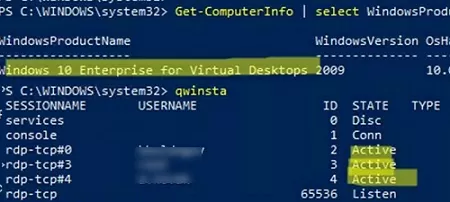
In this article, we have looked at a number of ways to get rid of the limit on the number of concurrent RDP user connections and run a free terminal server on desktop versions of Windows 10/11. Each method has its own advantages and disadvantages. Which one you choose is up to you.

